Components of the Body Circulatory System
VerifiedAdded on 2022/11/25
|25
|2548
|222
AI Summary
The circulatory system is composed of blood vessels, blood, and the heart. Its main function is to supply various body tissues with oxygen, blood hormones, and nutrients and also helps in the removal of different waste products from the body tissues. Learn about the different components and functions of the circulatory system.
Contribute Materials
Your contribution can guide someone’s learning journey. Share your
documents today.
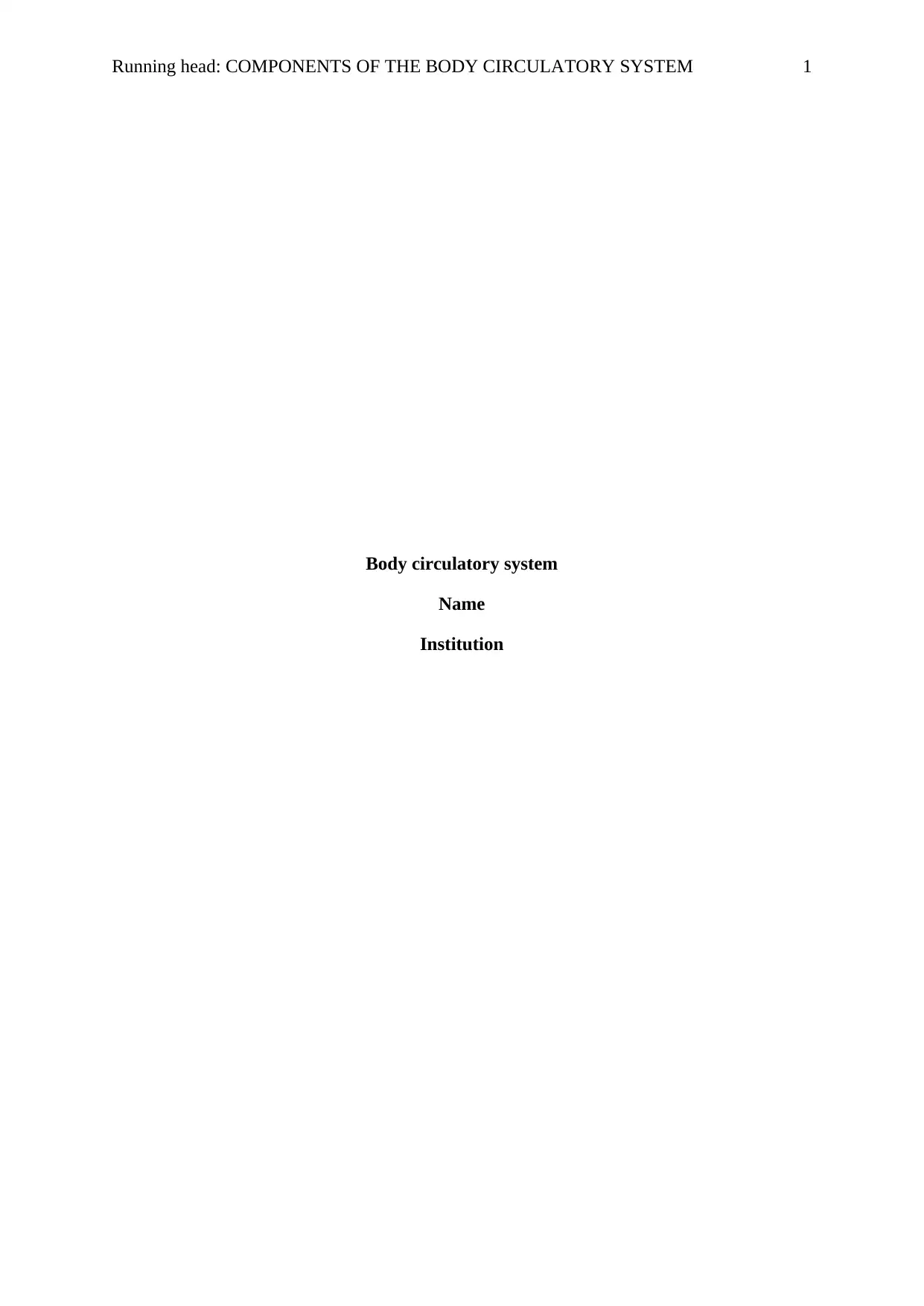
Running head: COMPONENTS OF THE BODY CIRCULATORY SYSTEM 1
Body circulatory system
Name
Institution
Body circulatory system
Name
Institution
Secure Best Marks with AI Grader
Need help grading? Try our AI Grader for instant feedback on your assignments.
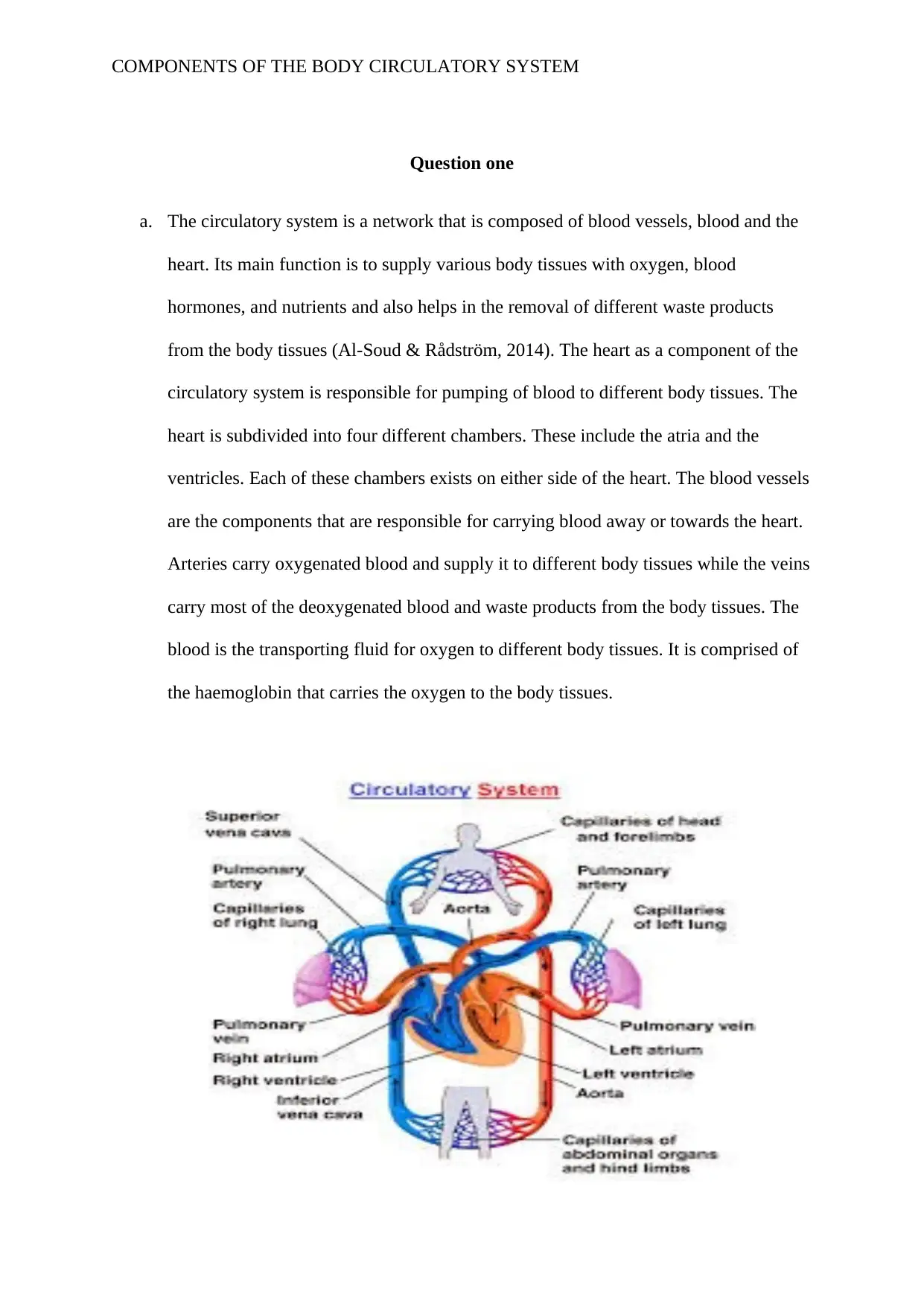
COMPONENTS OF THE BODY CIRCULATORY SYSTEM
Question one
a. The circulatory system is a network that is composed of blood vessels, blood and the
heart. Its main function is to supply various body tissues with oxygen, blood
hormones, and nutrients and also helps in the removal of different waste products
from the body tissues (Al-Soud & Rådström, 2014). The heart as a component of the
circulatory system is responsible for pumping of blood to different body tissues. The
heart is subdivided into four different chambers. These include the atria and the
ventricles. Each of these chambers exists on either side of the heart. The blood vessels
are the components that are responsible for carrying blood away or towards the heart.
Arteries carry oxygenated blood and supply it to different body tissues while the veins
carry most of the deoxygenated blood and waste products from the body tissues. The
blood is the transporting fluid for oxygen to different body tissues. It is comprised of
the haemoglobin that carries the oxygen to the body tissues.
Question one
a. The circulatory system is a network that is composed of blood vessels, blood and the
heart. Its main function is to supply various body tissues with oxygen, blood
hormones, and nutrients and also helps in the removal of different waste products
from the body tissues (Al-Soud & Rådström, 2014). The heart as a component of the
circulatory system is responsible for pumping of blood to different body tissues. The
heart is subdivided into four different chambers. These include the atria and the
ventricles. Each of these chambers exists on either side of the heart. The blood vessels
are the components that are responsible for carrying blood away or towards the heart.
Arteries carry oxygenated blood and supply it to different body tissues while the veins
carry most of the deoxygenated blood and waste products from the body tissues. The
blood is the transporting fluid for oxygen to different body tissues. It is comprised of
the haemoglobin that carries the oxygen to the body tissues.
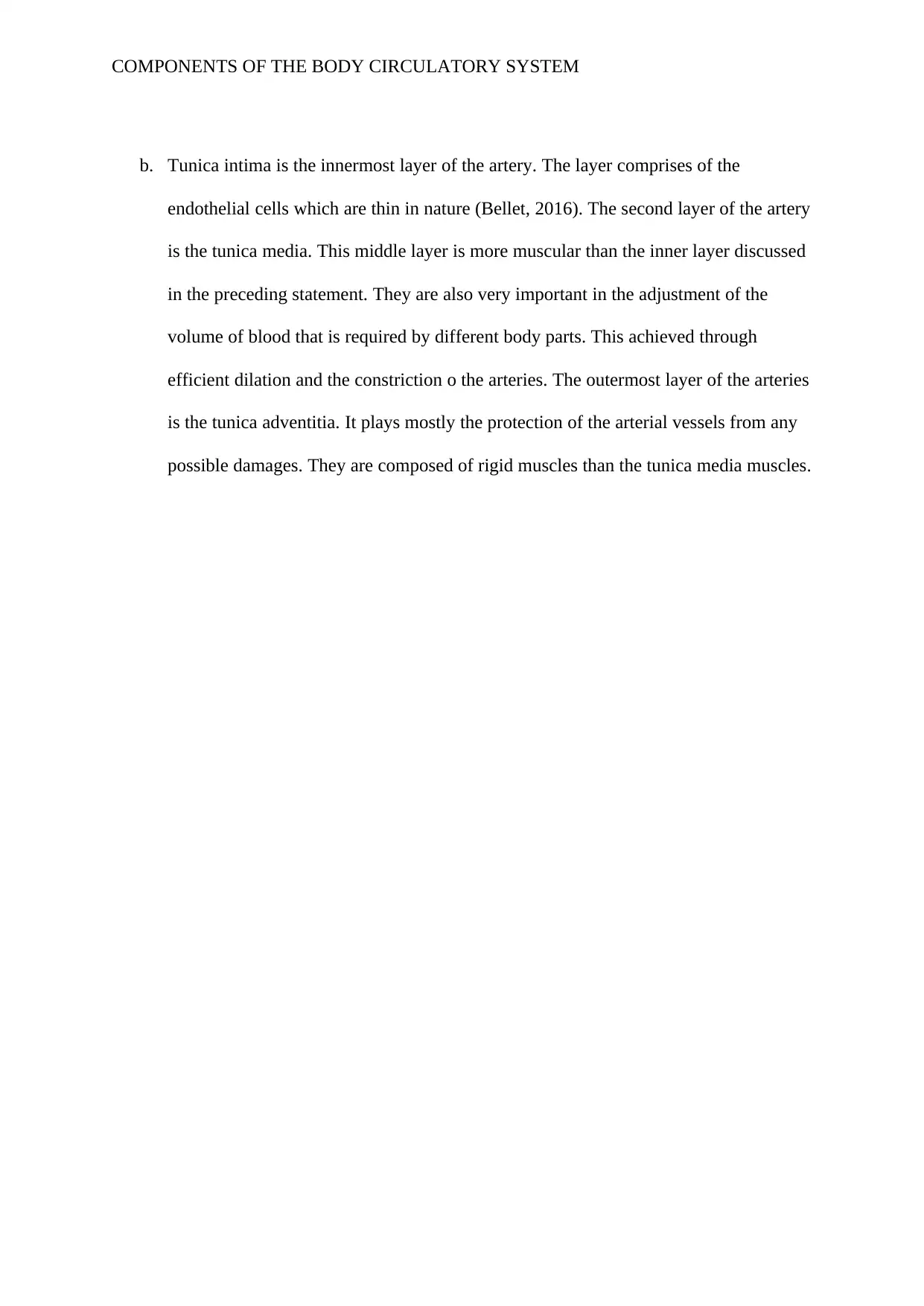
COMPONENTS OF THE BODY CIRCULATORY SYSTEM
b. Tunica intima is the innermost layer of the artery. The layer comprises of the
endothelial cells which are thin in nature (Bellet, 2016). The second layer of the artery
is the tunica media. This middle layer is more muscular than the inner layer discussed
in the preceding statement. They are also very important in the adjustment of the
volume of blood that is required by different body parts. This achieved through
efficient dilation and the constriction o the arteries. The outermost layer of the arteries
is the tunica adventitia. It plays mostly the protection of the arterial vessels from any
possible damages. They are composed of rigid muscles than the tunica media muscles.
b. Tunica intima is the innermost layer of the artery. The layer comprises of the
endothelial cells which are thin in nature (Bellet, 2016). The second layer of the artery
is the tunica media. This middle layer is more muscular than the inner layer discussed
in the preceding statement. They are also very important in the adjustment of the
volume of blood that is required by different body parts. This achieved through
efficient dilation and the constriction o the arteries. The outermost layer of the arteries
is the tunica adventitia. It plays mostly the protection of the arterial vessels from any
possible damages. They are composed of rigid muscles than the tunica media muscles.
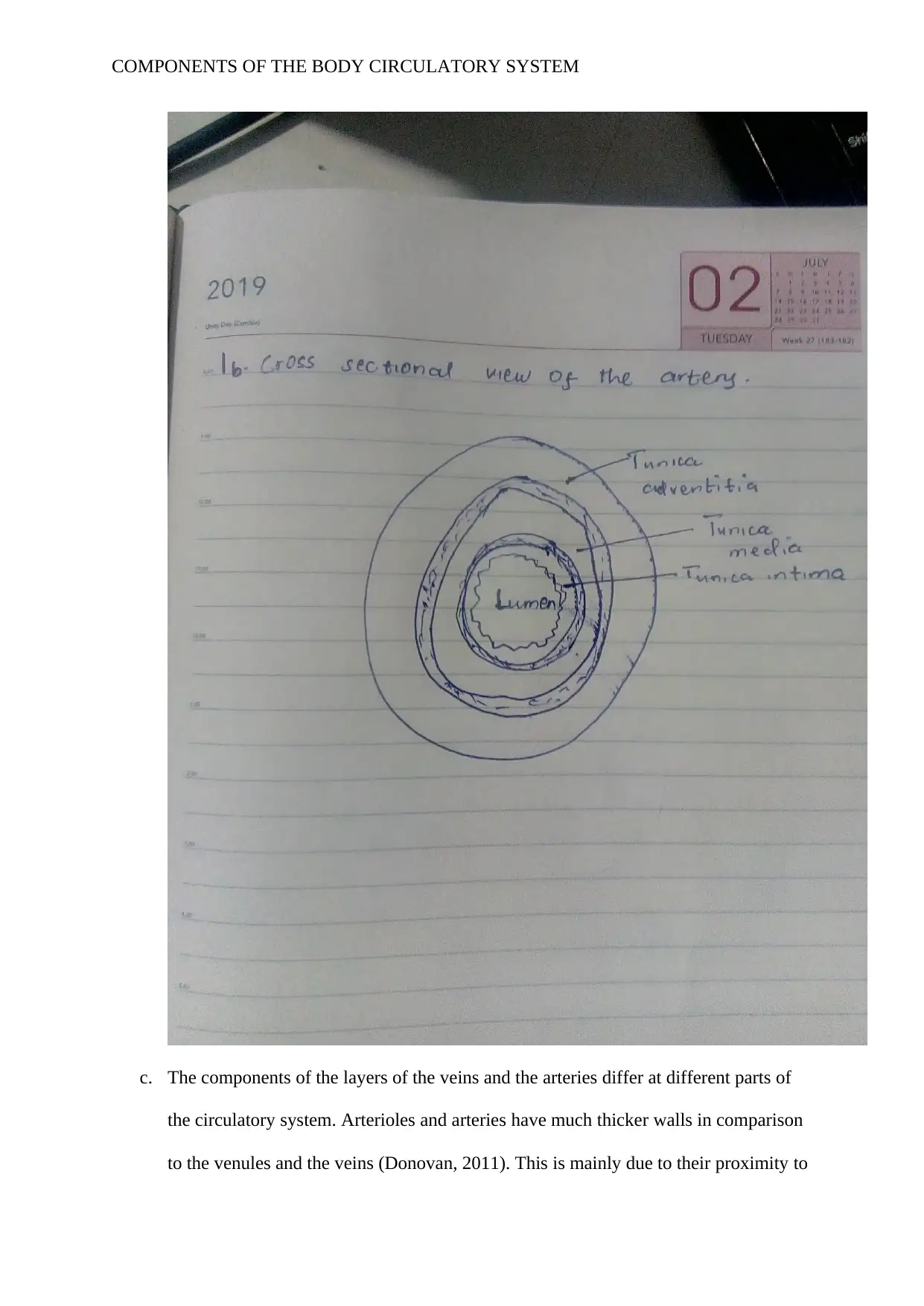
COMPONENTS OF THE BODY CIRCULATORY SYSTEM
c. The components of the layers of the veins and the arteries differ at different parts of
the circulatory system. Arterioles and arteries have much thicker walls in comparison
to the venules and the veins (Donovan, 2011). This is mainly due to their proximity to
c. The components of the layers of the veins and the arteries differ at different parts of
the circulatory system. Arterioles and arteries have much thicker walls in comparison
to the venules and the veins (Donovan, 2011). This is mainly due to their proximity to
Secure Best Marks with AI Grader
Need help grading? Try our AI Grader for instant feedback on your assignments.
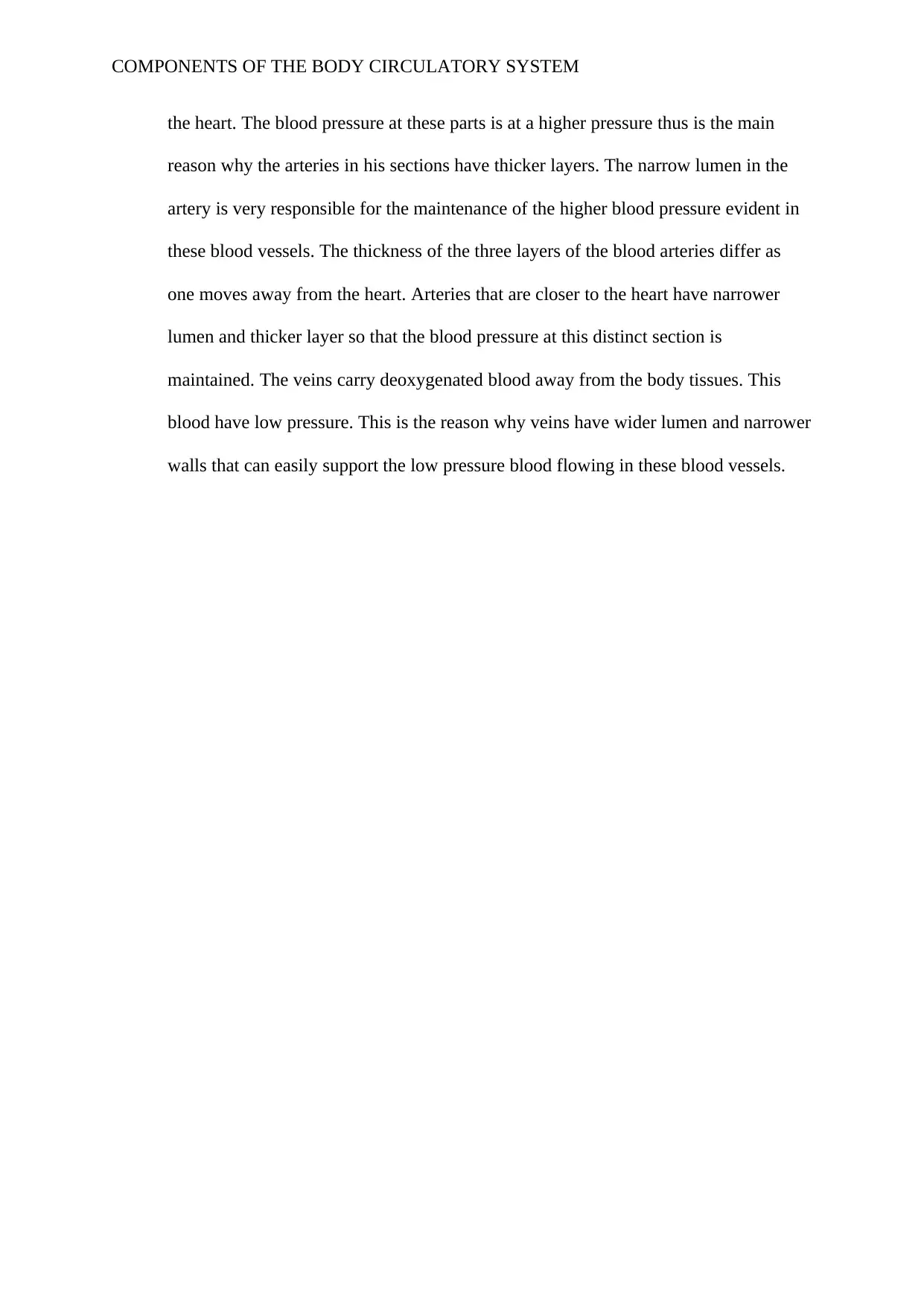
COMPONENTS OF THE BODY CIRCULATORY SYSTEM
the heart. The blood pressure at these parts is at a higher pressure thus is the main
reason why the arteries in his sections have thicker layers. The narrow lumen in the
artery is very responsible for the maintenance of the higher blood pressure evident in
these blood vessels. The thickness of the three layers of the blood arteries differ as
one moves away from the heart. Arteries that are closer to the heart have narrower
lumen and thicker layer so that the blood pressure at this distinct section is
maintained. The veins carry deoxygenated blood away from the body tissues. This
blood have low pressure. This is the reason why veins have wider lumen and narrower
walls that can easily support the low pressure blood flowing in these blood vessels.
the heart. The blood pressure at these parts is at a higher pressure thus is the main
reason why the arteries in his sections have thicker layers. The narrow lumen in the
artery is very responsible for the maintenance of the higher blood pressure evident in
these blood vessels. The thickness of the three layers of the blood arteries differ as
one moves away from the heart. Arteries that are closer to the heart have narrower
lumen and thicker layer so that the blood pressure at this distinct section is
maintained. The veins carry deoxygenated blood away from the body tissues. This
blood have low pressure. This is the reason why veins have wider lumen and narrower
walls that can easily support the low pressure blood flowing in these blood vessels.
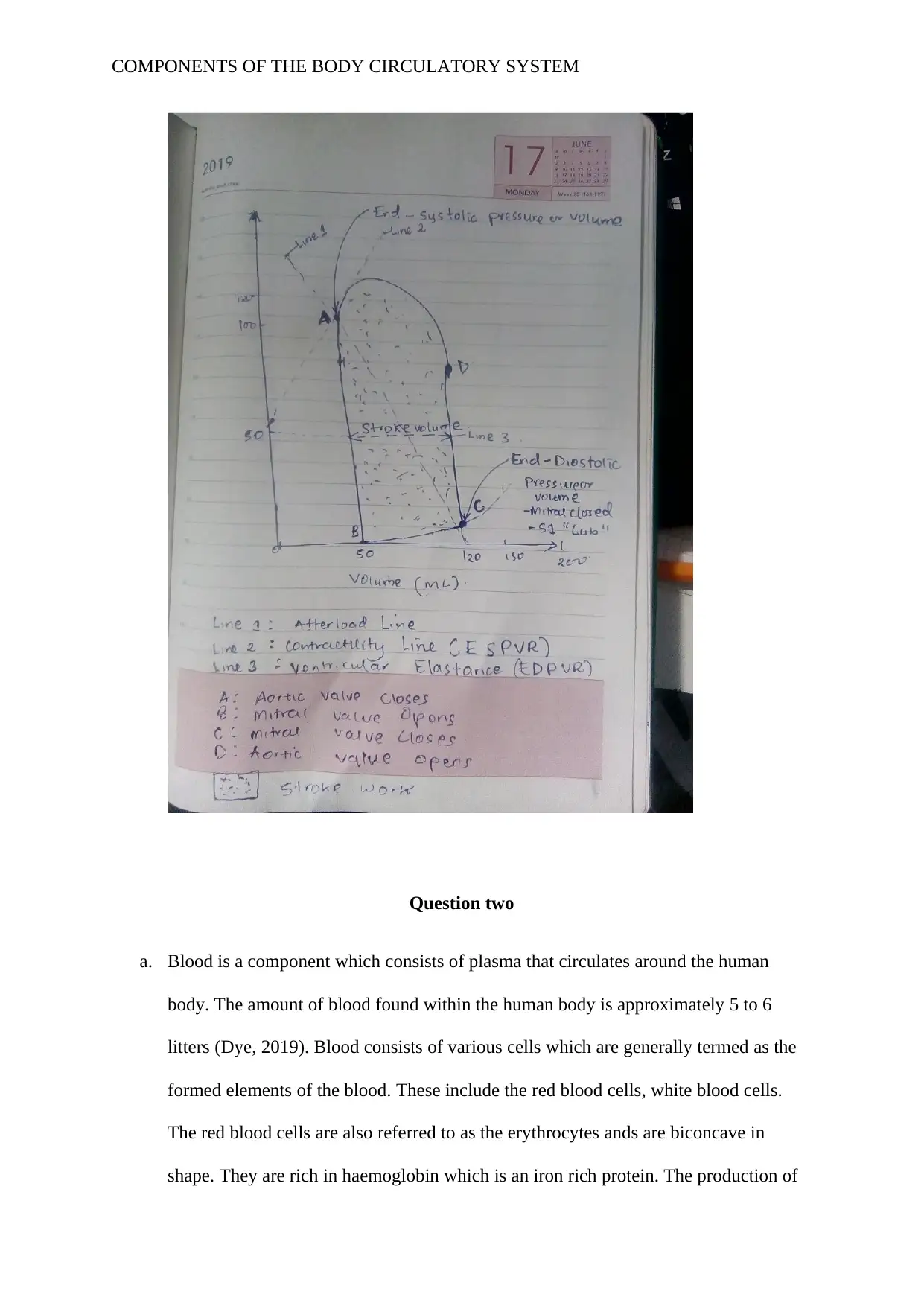
COMPONENTS OF THE BODY CIRCULATORY SYSTEM
Question two
a. Blood is a component which consists of plasma that circulates around the human
body. The amount of blood found within the human body is approximately 5 to 6
litters (Dye, 2019). Blood consists of various cells which are generally termed as the
formed elements of the blood. These include the red blood cells, white blood cells.
The red blood cells are also referred to as the erythrocytes ands are biconcave in
shape. They are rich in haemoglobin which is an iron rich protein. The production of
Question two
a. Blood is a component which consists of plasma that circulates around the human
body. The amount of blood found within the human body is approximately 5 to 6
litters (Dye, 2019). Blood consists of various cells which are generally termed as the
formed elements of the blood. These include the red blood cells, white blood cells.
The red blood cells are also referred to as the erythrocytes ands are biconcave in
shape. They are rich in haemoglobin which is an iron rich protein. The production of
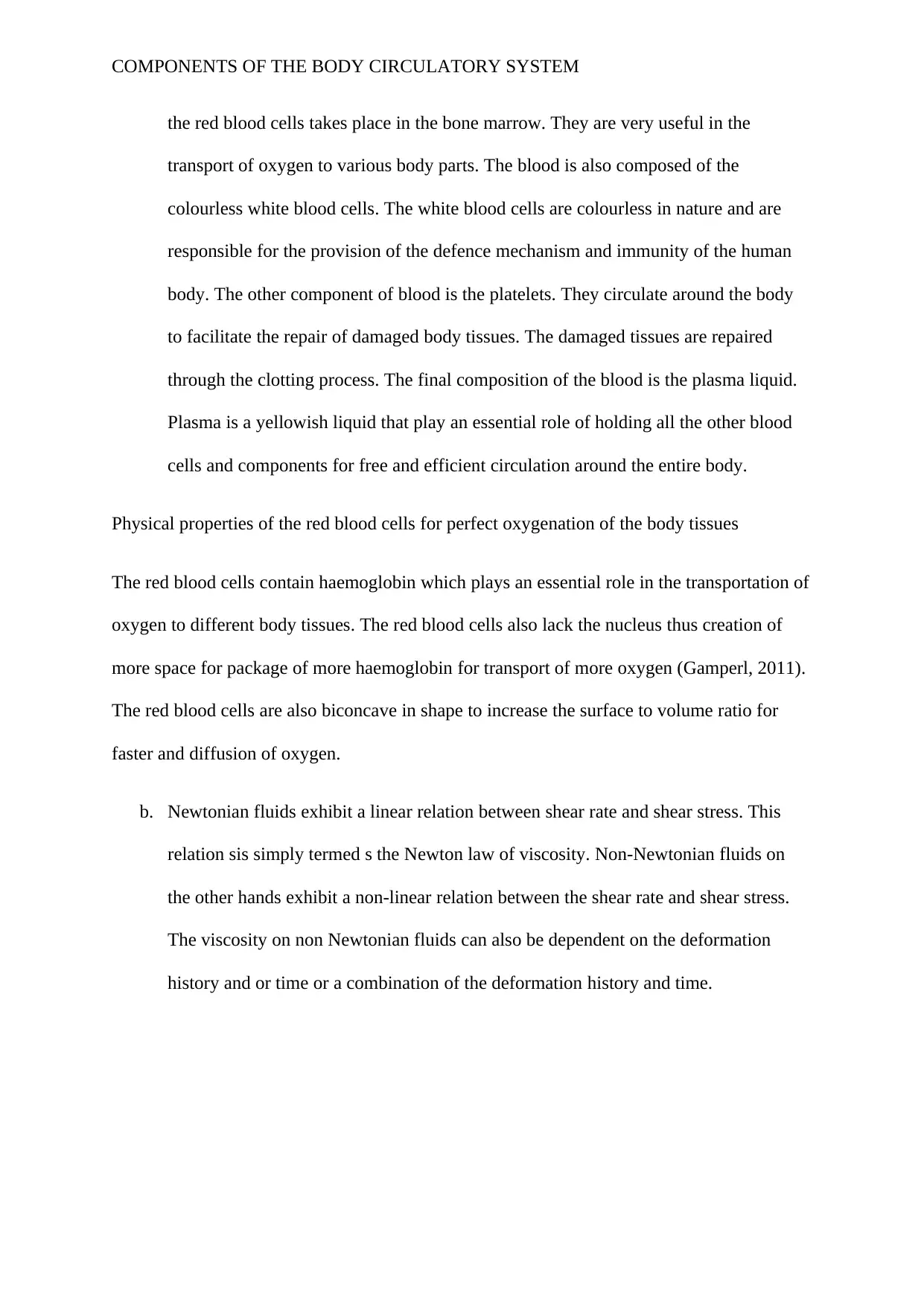
COMPONENTS OF THE BODY CIRCULATORY SYSTEM
the red blood cells takes place in the bone marrow. They are very useful in the
transport of oxygen to various body parts. The blood is also composed of the
colourless white blood cells. The white blood cells are colourless in nature and are
responsible for the provision of the defence mechanism and immunity of the human
body. The other component of blood is the platelets. They circulate around the body
to facilitate the repair of damaged body tissues. The damaged tissues are repaired
through the clotting process. The final composition of the blood is the plasma liquid.
Plasma is a yellowish liquid that play an essential role of holding all the other blood
cells and components for free and efficient circulation around the entire body.
Physical properties of the red blood cells for perfect oxygenation of the body tissues
The red blood cells contain haemoglobin which plays an essential role in the transportation of
oxygen to different body tissues. The red blood cells also lack the nucleus thus creation of
more space for package of more haemoglobin for transport of more oxygen (Gamperl, 2011).
The red blood cells are also biconcave in shape to increase the surface to volume ratio for
faster and diffusion of oxygen.
b. Newtonian fluids exhibit a linear relation between shear rate and shear stress. This
relation sis simply termed s the Newton law of viscosity. Non-Newtonian fluids on
the other hands exhibit a non-linear relation between the shear rate and shear stress.
The viscosity on non Newtonian fluids can also be dependent on the deformation
history and or time or a combination of the deformation history and time.
the red blood cells takes place in the bone marrow. They are very useful in the
transport of oxygen to various body parts. The blood is also composed of the
colourless white blood cells. The white blood cells are colourless in nature and are
responsible for the provision of the defence mechanism and immunity of the human
body. The other component of blood is the platelets. They circulate around the body
to facilitate the repair of damaged body tissues. The damaged tissues are repaired
through the clotting process. The final composition of the blood is the plasma liquid.
Plasma is a yellowish liquid that play an essential role of holding all the other blood
cells and components for free and efficient circulation around the entire body.
Physical properties of the red blood cells for perfect oxygenation of the body tissues
The red blood cells contain haemoglobin which plays an essential role in the transportation of
oxygen to different body tissues. The red blood cells also lack the nucleus thus creation of
more space for package of more haemoglobin for transport of more oxygen (Gamperl, 2011).
The red blood cells are also biconcave in shape to increase the surface to volume ratio for
faster and diffusion of oxygen.
b. Newtonian fluids exhibit a linear relation between shear rate and shear stress. This
relation sis simply termed s the Newton law of viscosity. Non-Newtonian fluids on
the other hands exhibit a non-linear relation between the shear rate and shear stress.
The viscosity on non Newtonian fluids can also be dependent on the deformation
history and or time or a combination of the deformation history and time.
Paraphrase This Document
Need a fresh take? Get an instant paraphrase of this document with our AI Paraphraser
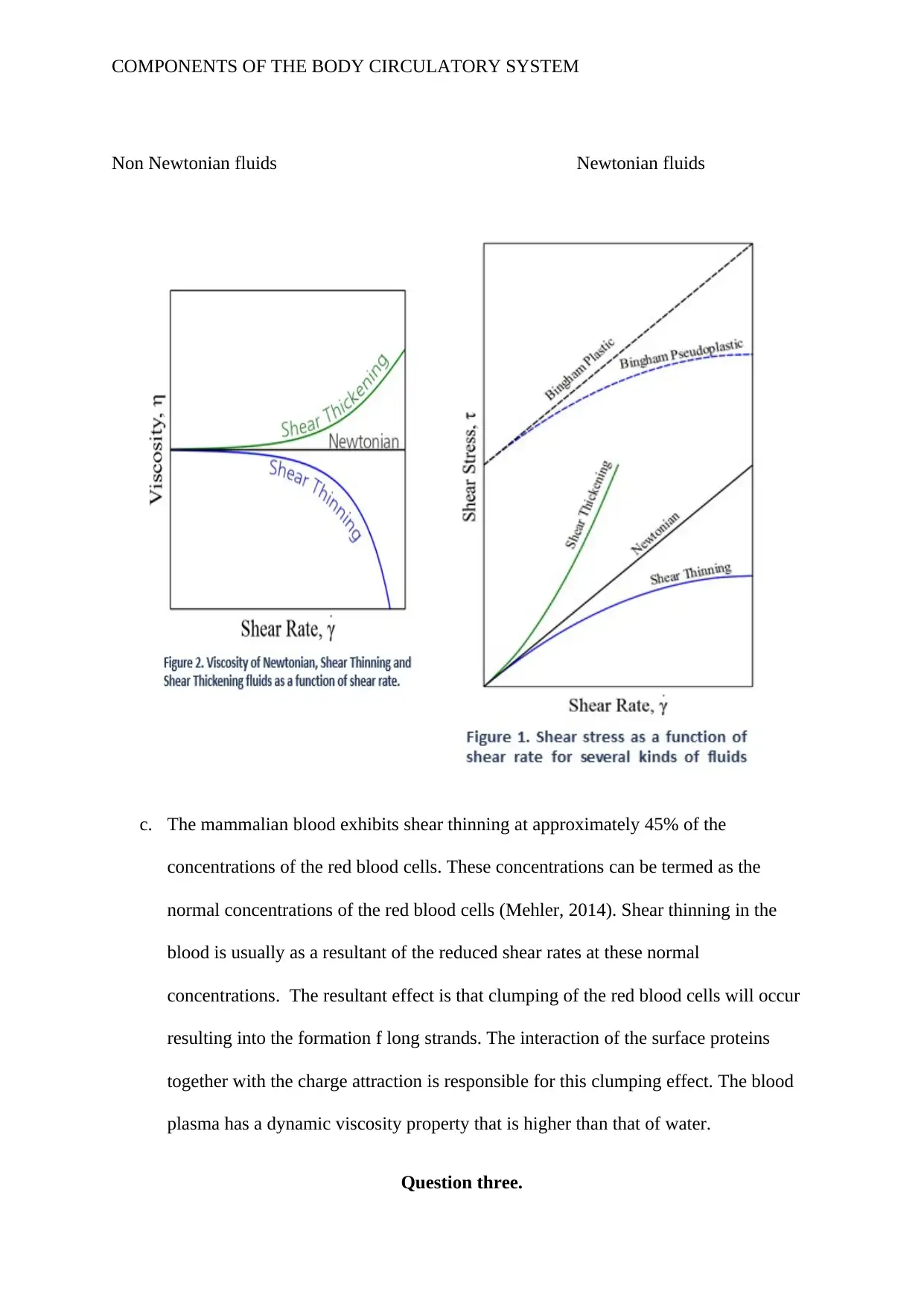
COMPONENTS OF THE BODY CIRCULATORY SYSTEM
Non Newtonian fluids Newtonian fluids
c. The mammalian blood exhibits shear thinning at approximately 45% of the
concentrations of the red blood cells. These concentrations can be termed as the
normal concentrations of the red blood cells (Mehler, 2014). Shear thinning in the
blood is usually as a resultant of the reduced shear rates at these normal
concentrations. The resultant effect is that clumping of the red blood cells will occur
resulting into the formation f long strands. The interaction of the surface proteins
together with the charge attraction is responsible for this clumping effect. The blood
plasma has a dynamic viscosity property that is higher than that of water.
Question three.
Non Newtonian fluids Newtonian fluids
c. The mammalian blood exhibits shear thinning at approximately 45% of the
concentrations of the red blood cells. These concentrations can be termed as the
normal concentrations of the red blood cells (Mehler, 2014). Shear thinning in the
blood is usually as a resultant of the reduced shear rates at these normal
concentrations. The resultant effect is that clumping of the red blood cells will occur
resulting into the formation f long strands. The interaction of the surface proteins
together with the charge attraction is responsible for this clumping effect. The blood
plasma has a dynamic viscosity property that is higher than that of water.
Question three.
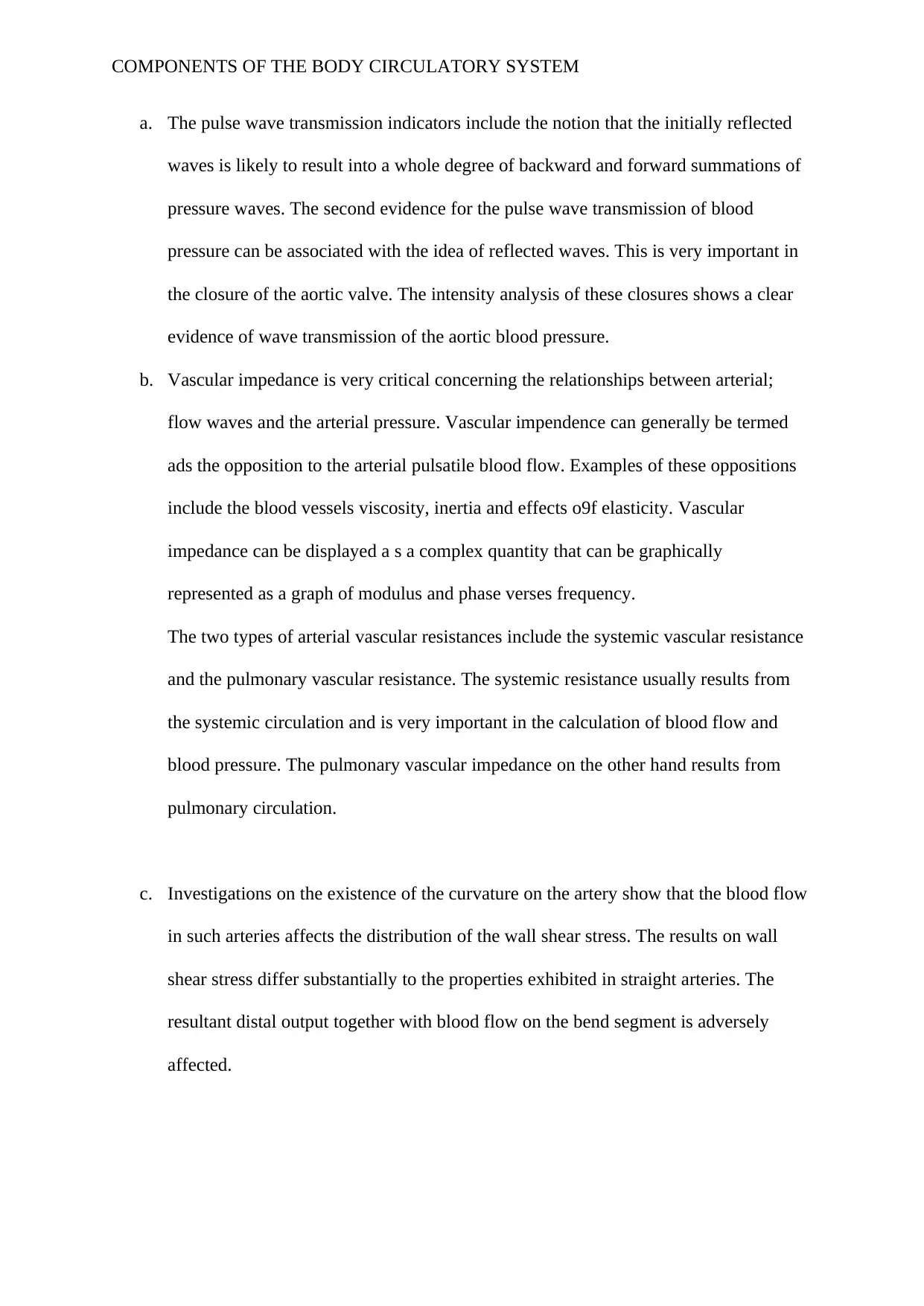
COMPONENTS OF THE BODY CIRCULATORY SYSTEM
a. The pulse wave transmission indicators include the notion that the initially reflected
waves is likely to result into a whole degree of backward and forward summations of
pressure waves. The second evidence for the pulse wave transmission of blood
pressure can be associated with the idea of reflected waves. This is very important in
the closure of the aortic valve. The intensity analysis of these closures shows a clear
evidence of wave transmission of the aortic blood pressure.
b. Vascular impedance is very critical concerning the relationships between arterial;
flow waves and the arterial pressure. Vascular impendence can generally be termed
ads the opposition to the arterial pulsatile blood flow. Examples of these oppositions
include the blood vessels viscosity, inertia and effects o9f elasticity. Vascular
impedance can be displayed a s a complex quantity that can be graphically
represented as a graph of modulus and phase verses frequency.
The two types of arterial vascular resistances include the systemic vascular resistance
and the pulmonary vascular resistance. The systemic resistance usually results from
the systemic circulation and is very important in the calculation of blood flow and
blood pressure. The pulmonary vascular impedance on the other hand results from
pulmonary circulation.
c. Investigations on the existence of the curvature on the artery show that the blood flow
in such arteries affects the distribution of the wall shear stress. The results on wall
shear stress differ substantially to the properties exhibited in straight arteries. The
resultant distal output together with blood flow on the bend segment is adversely
affected.
a. The pulse wave transmission indicators include the notion that the initially reflected
waves is likely to result into a whole degree of backward and forward summations of
pressure waves. The second evidence for the pulse wave transmission of blood
pressure can be associated with the idea of reflected waves. This is very important in
the closure of the aortic valve. The intensity analysis of these closures shows a clear
evidence of wave transmission of the aortic blood pressure.
b. Vascular impedance is very critical concerning the relationships between arterial;
flow waves and the arterial pressure. Vascular impendence can generally be termed
ads the opposition to the arterial pulsatile blood flow. Examples of these oppositions
include the blood vessels viscosity, inertia and effects o9f elasticity. Vascular
impedance can be displayed a s a complex quantity that can be graphically
represented as a graph of modulus and phase verses frequency.
The two types of arterial vascular resistances include the systemic vascular resistance
and the pulmonary vascular resistance. The systemic resistance usually results from
the systemic circulation and is very important in the calculation of blood flow and
blood pressure. The pulmonary vascular impedance on the other hand results from
pulmonary circulation.
c. Investigations on the existence of the curvature on the artery show that the blood flow
in such arteries affects the distribution of the wall shear stress. The results on wall
shear stress differ substantially to the properties exhibited in straight arteries. The
resultant distal output together with blood flow on the bend segment is adversely
affected.
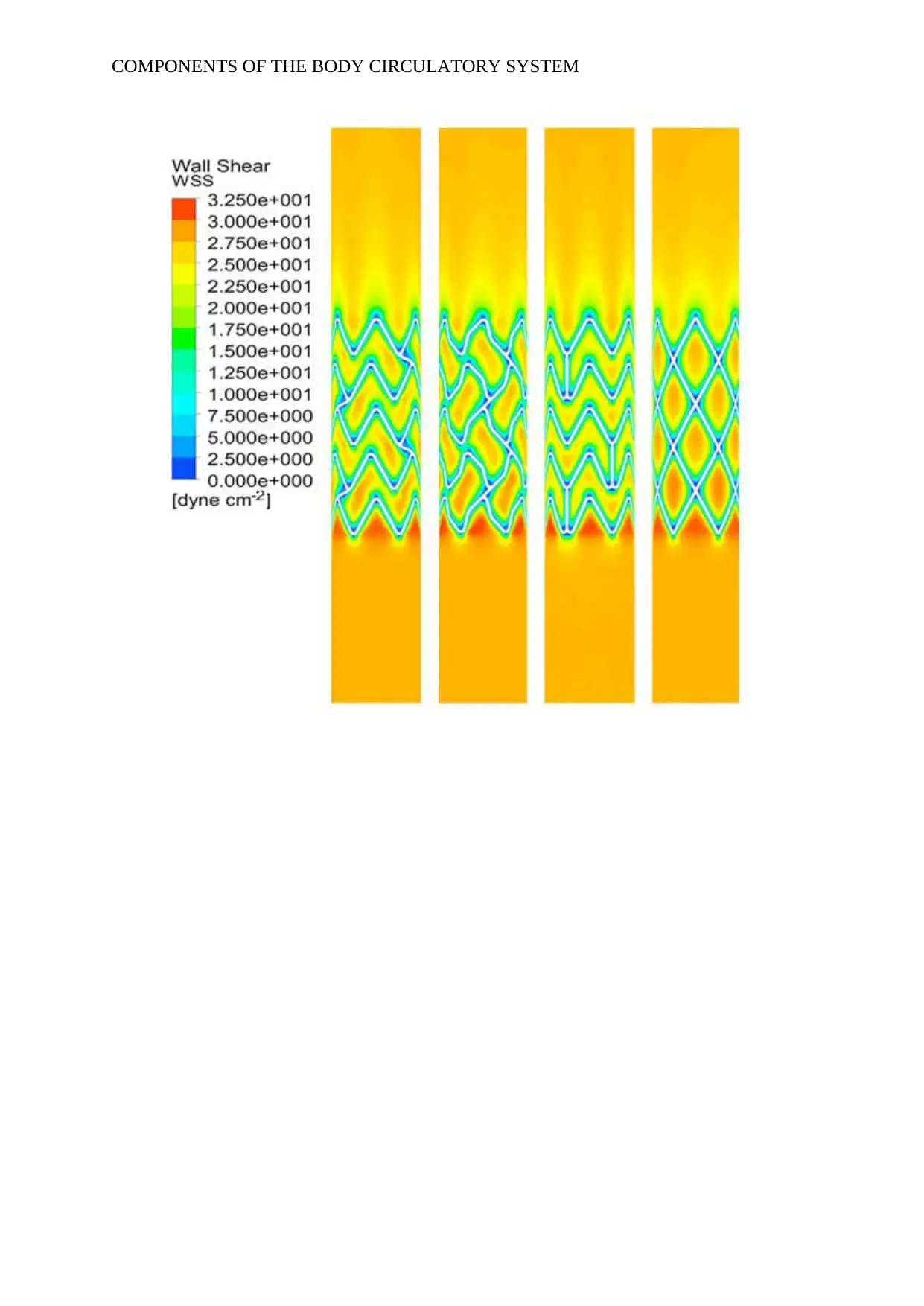
COMPONENTS OF THE BODY CIRCULATORY SYSTEM
Secure Best Marks with AI Grader
Need help grading? Try our AI Grader for instant feedback on your assignments.
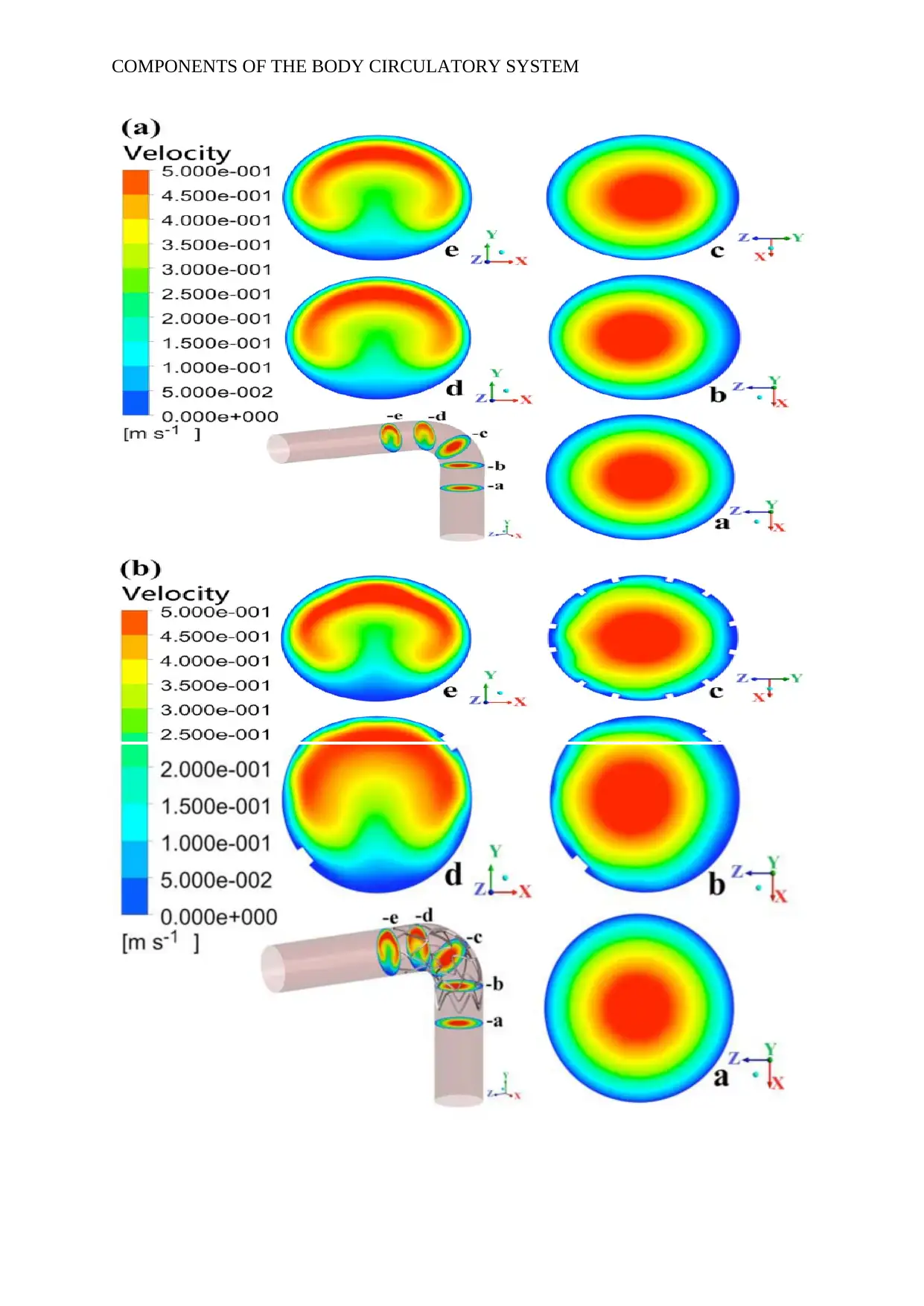
COMPONENTS OF THE BODY CIRCULATORY SYSTEM
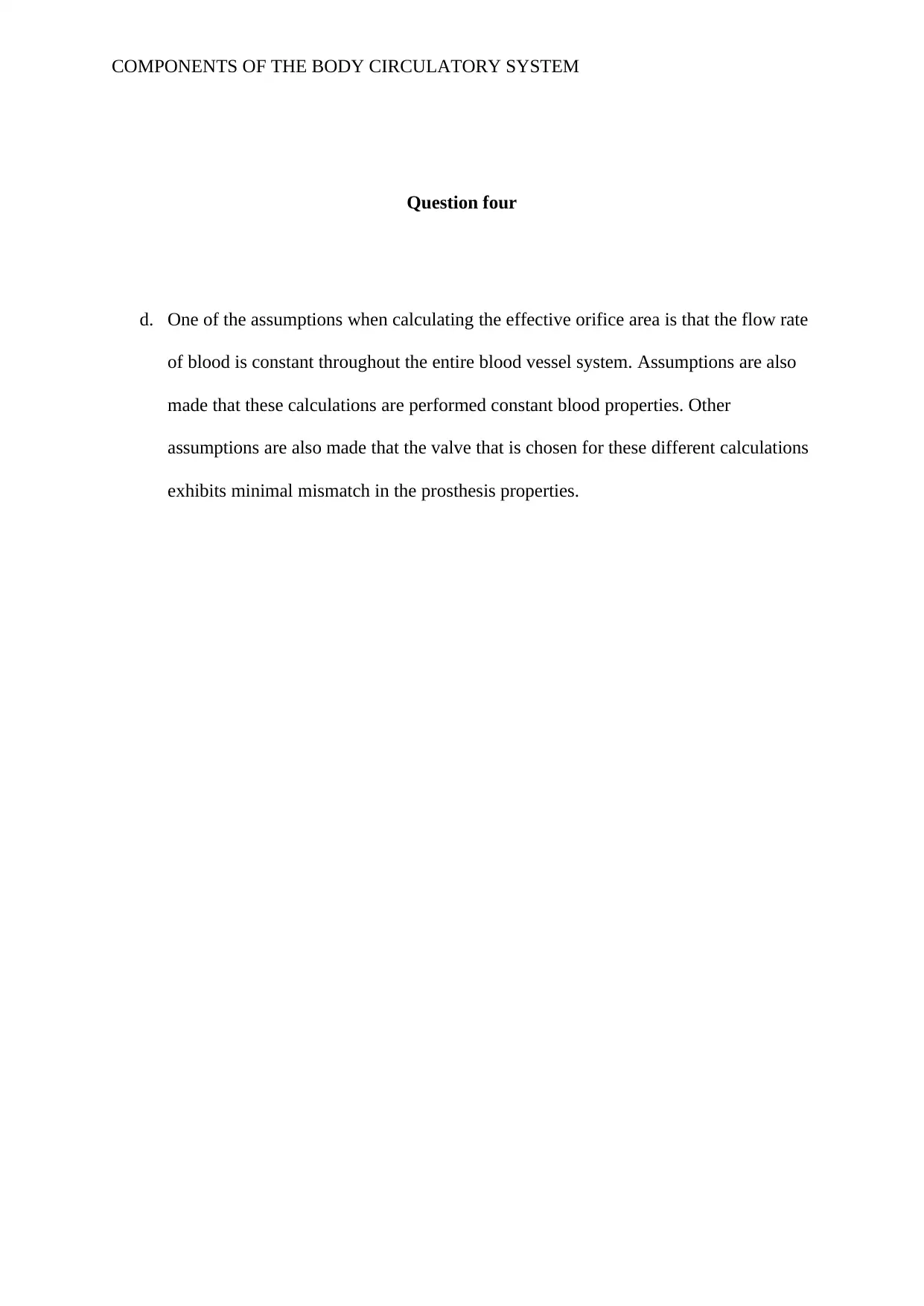
COMPONENTS OF THE BODY CIRCULATORY SYSTEM
Question four
d. One of the assumptions when calculating the effective orifice area is that the flow rate
of blood is constant throughout the entire blood vessel system. Assumptions are also
made that these calculations are performed constant blood properties. Other
assumptions are also made that the valve that is chosen for these different calculations
exhibits minimal mismatch in the prosthesis properties.
Question four
d. One of the assumptions when calculating the effective orifice area is that the flow rate
of blood is constant throughout the entire blood vessel system. Assumptions are also
made that these calculations are performed constant blood properties. Other
assumptions are also made that the valve that is chosen for these different calculations
exhibits minimal mismatch in the prosthesis properties.
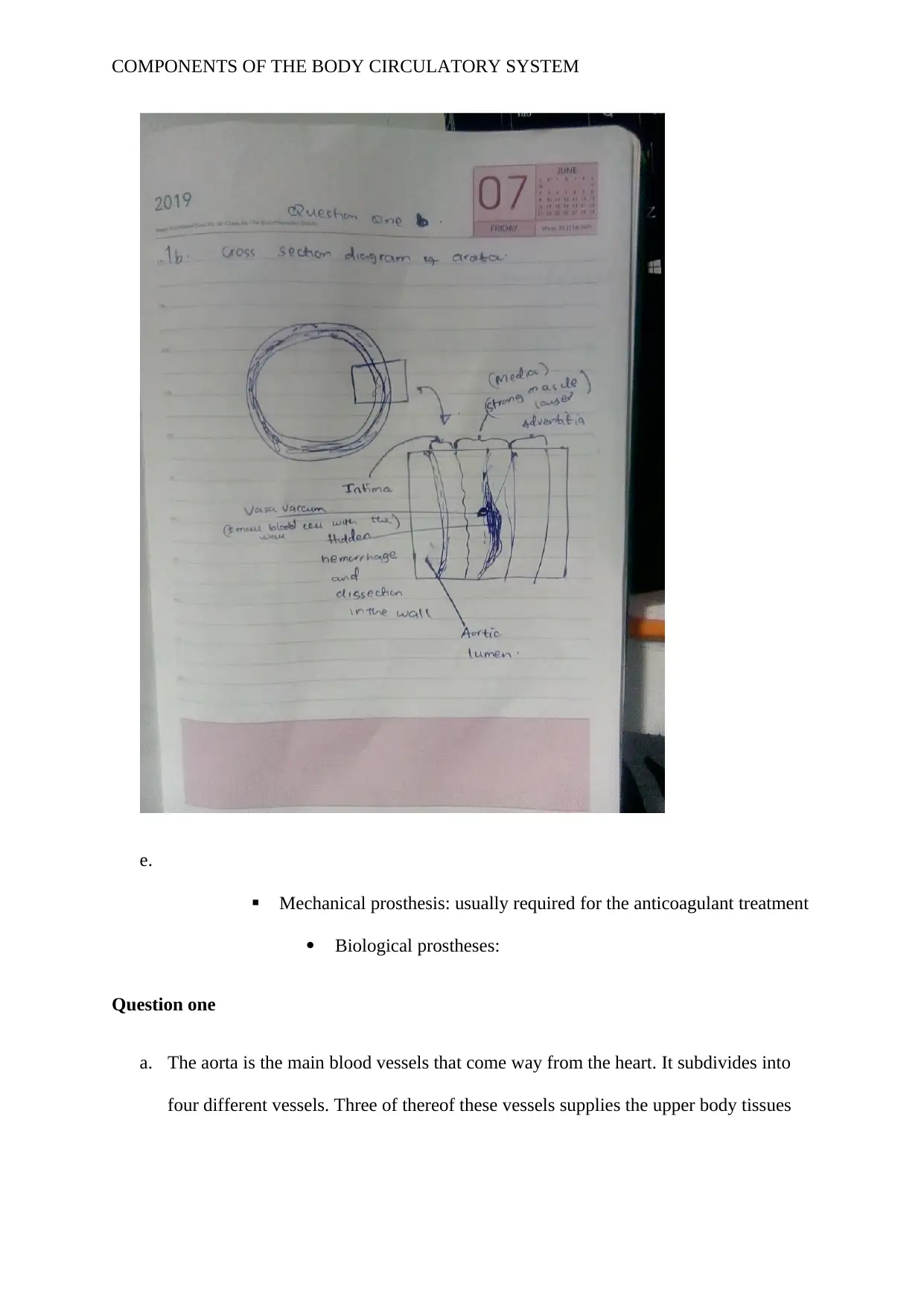
COMPONENTS OF THE BODY CIRCULATORY SYSTEM
e.
Mechanical prosthesis: usually required for the anticoagulant treatment
Biological prostheses:
Question one
a. The aorta is the main blood vessels that come way from the heart. It subdivides into
four different vessels. Three of thereof these vessels supplies the upper body tissues
e.
Mechanical prosthesis: usually required for the anticoagulant treatment
Biological prostheses:
Question one
a. The aorta is the main blood vessels that come way from the heart. It subdivides into
four different vessels. Three of thereof these vessels supplies the upper body tissues
Paraphrase This Document
Need a fresh take? Get an instant paraphrase of this document with our AI Paraphraser
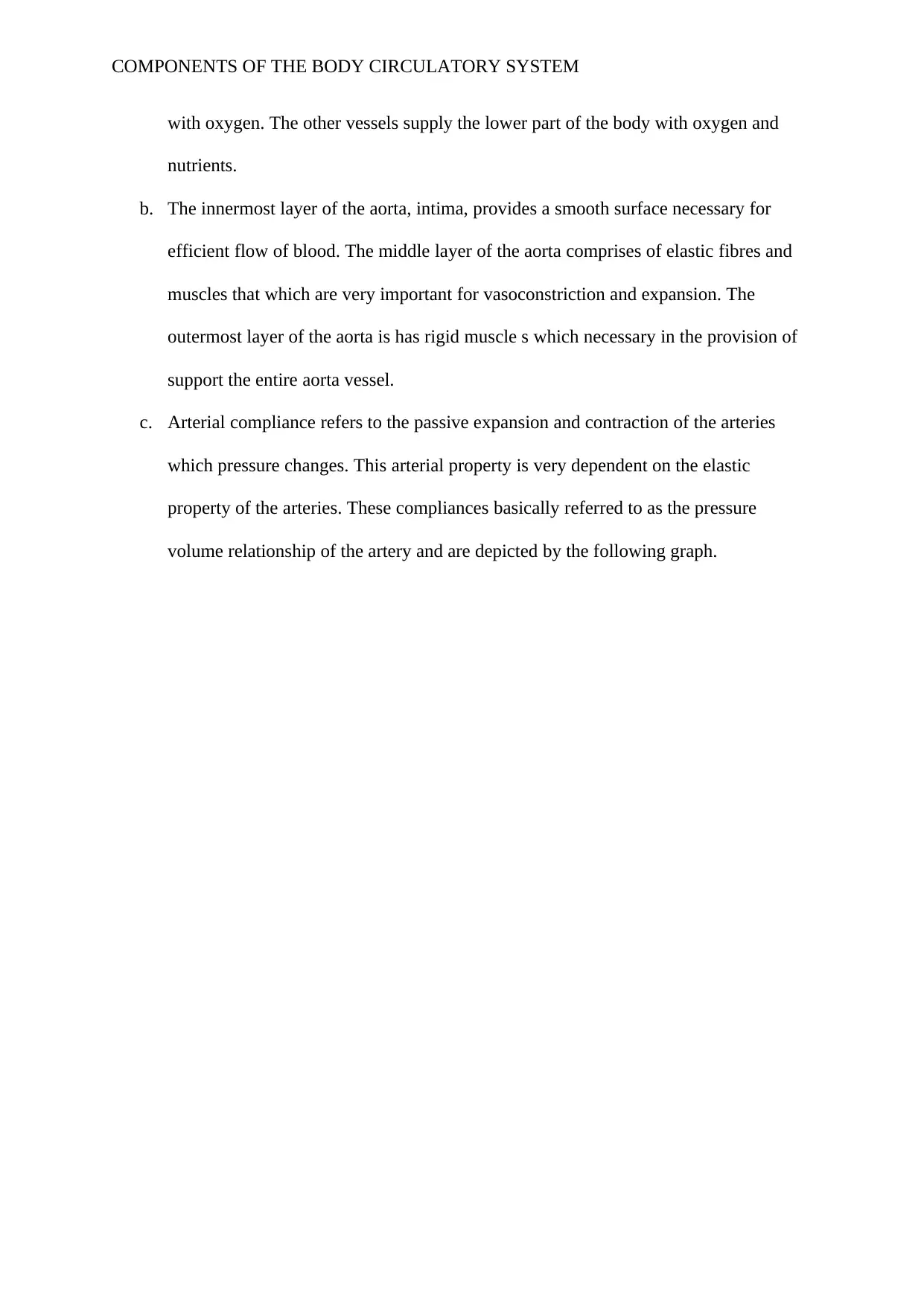
COMPONENTS OF THE BODY CIRCULATORY SYSTEM
with oxygen. The other vessels supply the lower part of the body with oxygen and
nutrients.
b. The innermost layer of the aorta, intima, provides a smooth surface necessary for
efficient flow of blood. The middle layer of the aorta comprises of elastic fibres and
muscles that which are very important for vasoconstriction and expansion. The
outermost layer of the aorta is has rigid muscle s which necessary in the provision of
support the entire aorta vessel.
c. Arterial compliance refers to the passive expansion and contraction of the arteries
which pressure changes. This arterial property is very dependent on the elastic
property of the arteries. These compliances basically referred to as the pressure
volume relationship of the artery and are depicted by the following graph.
with oxygen. The other vessels supply the lower part of the body with oxygen and
nutrients.
b. The innermost layer of the aorta, intima, provides a smooth surface necessary for
efficient flow of blood. The middle layer of the aorta comprises of elastic fibres and
muscles that which are very important for vasoconstriction and expansion. The
outermost layer of the aorta is has rigid muscle s which necessary in the provision of
support the entire aorta vessel.
c. Arterial compliance refers to the passive expansion and contraction of the arteries
which pressure changes. This arterial property is very dependent on the elastic
property of the arteries. These compliances basically referred to as the pressure
volume relationship of the artery and are depicted by the following graph.
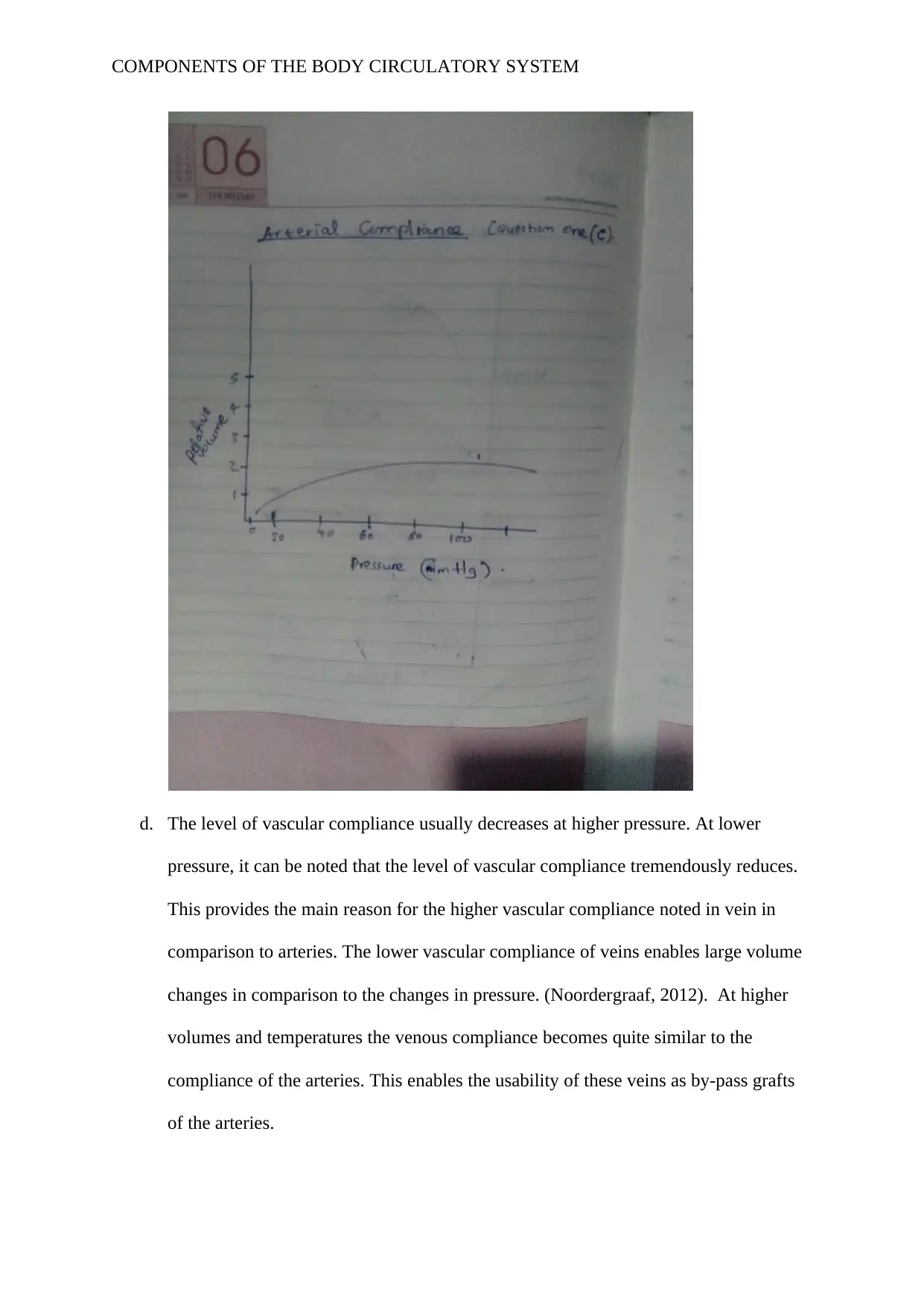
COMPONENTS OF THE BODY CIRCULATORY SYSTEM
d. The level of vascular compliance usually decreases at higher pressure. At lower
pressure, it can be noted that the level of vascular compliance tremendously reduces.
This provides the main reason for the higher vascular compliance noted in vein in
comparison to arteries. The lower vascular compliance of veins enables large volume
changes in comparison to the changes in pressure. (Noordergraaf, 2012). At higher
volumes and temperatures the venous compliance becomes quite similar to the
compliance of the arteries. This enables the usability of these veins as by-pass grafts
of the arteries.
d. The level of vascular compliance usually decreases at higher pressure. At lower
pressure, it can be noted that the level of vascular compliance tremendously reduces.
This provides the main reason for the higher vascular compliance noted in vein in
comparison to arteries. The lower vascular compliance of veins enables large volume
changes in comparison to the changes in pressure. (Noordergraaf, 2012). At higher
volumes and temperatures the venous compliance becomes quite similar to the
compliance of the arteries. This enables the usability of these veins as by-pass grafts
of the arteries.
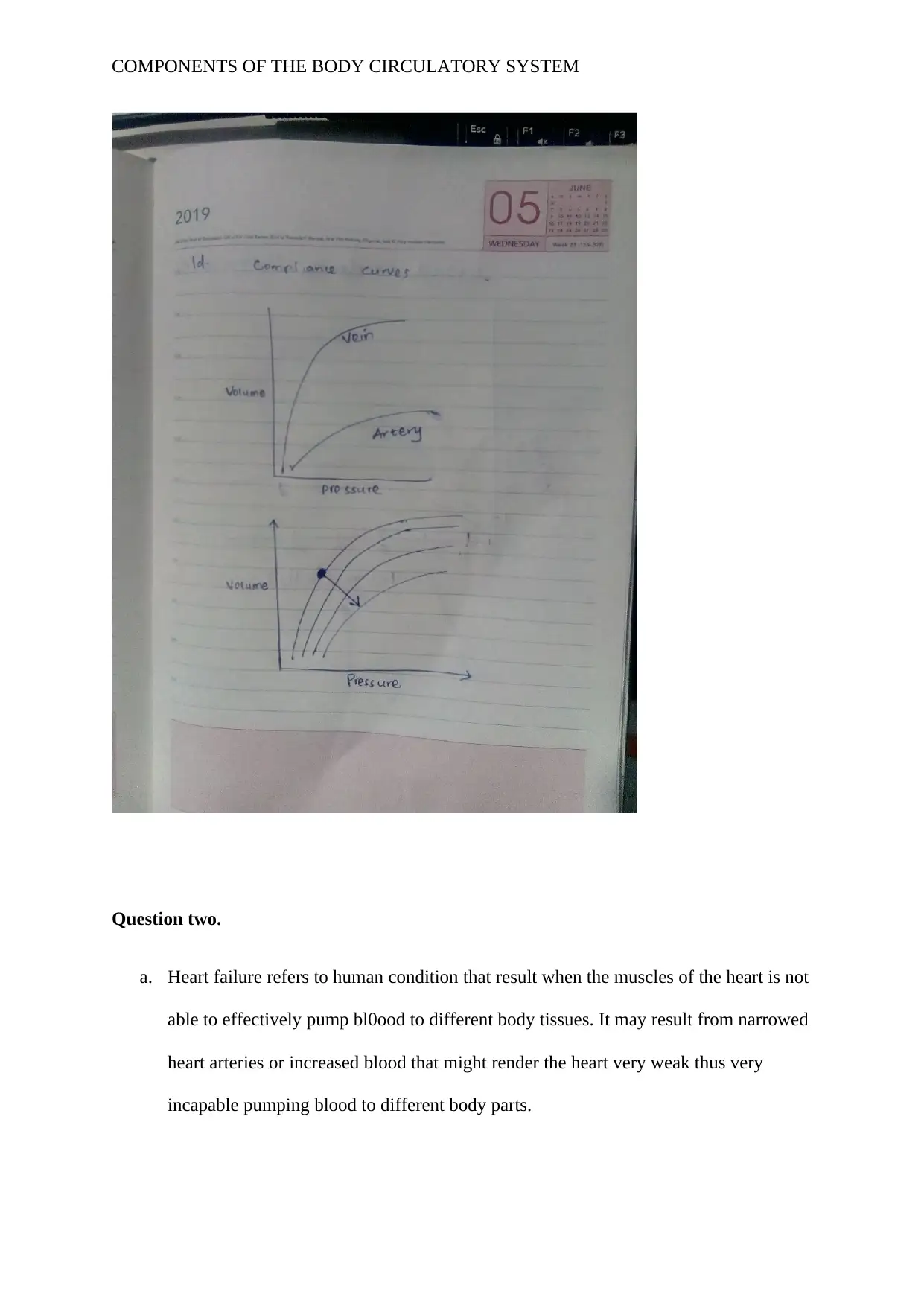
COMPONENTS OF THE BODY CIRCULATORY SYSTEM
Question two.
a. Heart failure refers to human condition that result when the muscles of the heart is not
able to effectively pump bl0ood to different body tissues. It may result from narrowed
heart arteries or increased blood that might render the heart very weak thus very
incapable pumping blood to different body parts.
Question two.
a. Heart failure refers to human condition that result when the muscles of the heart is not
able to effectively pump bl0ood to different body tissues. It may result from narrowed
heart arteries or increased blood that might render the heart very weak thus very
incapable pumping blood to different body parts.
Secure Best Marks with AI Grader
Need help grading? Try our AI Grader for instant feedback on your assignments.
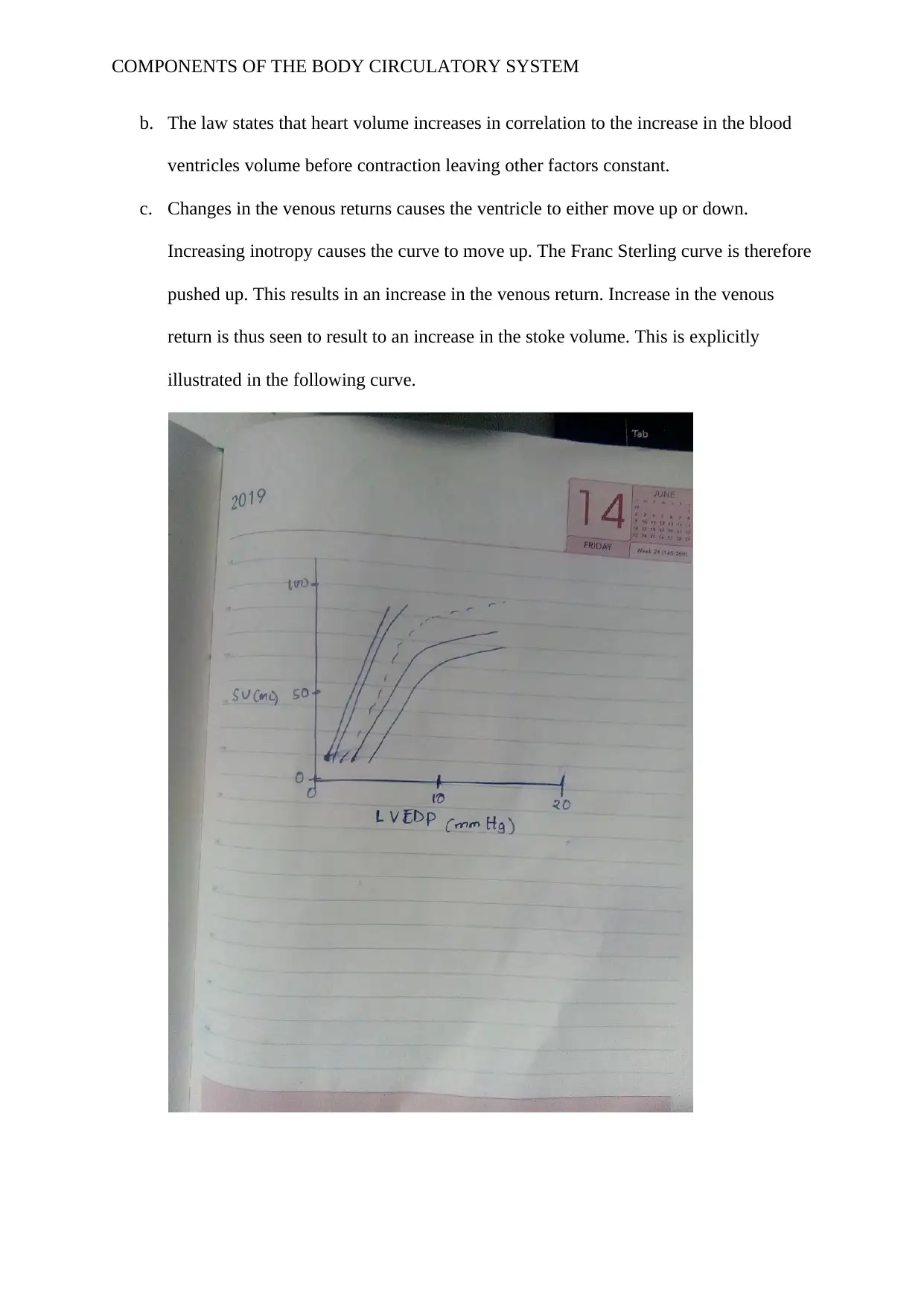
COMPONENTS OF THE BODY CIRCULATORY SYSTEM
b. The law states that heart volume increases in correlation to the increase in the blood
ventricles volume before contraction leaving other factors constant.
c. Changes in the venous returns causes the ventricle to either move up or down.
Increasing inotropy causes the curve to move up. The Franc Sterling curve is therefore
pushed up. This results in an increase in the venous return. Increase in the venous
return is thus seen to result to an increase in the stoke volume. This is explicitly
illustrated in the following curve.
b. The law states that heart volume increases in correlation to the increase in the blood
ventricles volume before contraction leaving other factors constant.
c. Changes in the venous returns causes the ventricle to either move up or down.
Increasing inotropy causes the curve to move up. The Franc Sterling curve is therefore
pushed up. This results in an increase in the venous return. Increase in the venous
return is thus seen to result to an increase in the stoke volume. This is explicitly
illustrated in the following curve.
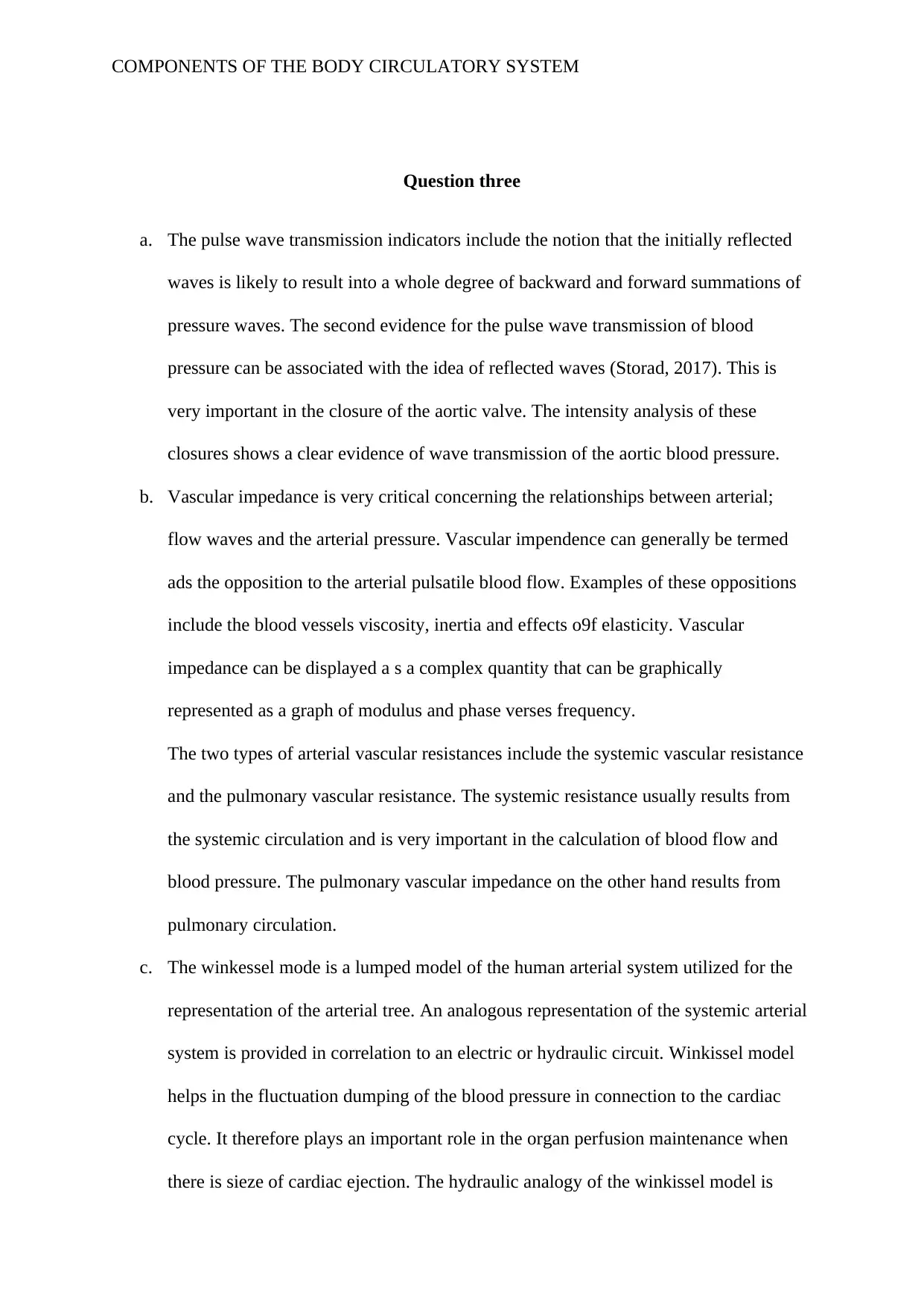
COMPONENTS OF THE BODY CIRCULATORY SYSTEM
Question three
a. The pulse wave transmission indicators include the notion that the initially reflected
waves is likely to result into a whole degree of backward and forward summations of
pressure waves. The second evidence for the pulse wave transmission of blood
pressure can be associated with the idea of reflected waves (Storad, 2017). This is
very important in the closure of the aortic valve. The intensity analysis of these
closures shows a clear evidence of wave transmission of the aortic blood pressure.
b. Vascular impedance is very critical concerning the relationships between arterial;
flow waves and the arterial pressure. Vascular impendence can generally be termed
ads the opposition to the arterial pulsatile blood flow. Examples of these oppositions
include the blood vessels viscosity, inertia and effects o9f elasticity. Vascular
impedance can be displayed a s a complex quantity that can be graphically
represented as a graph of modulus and phase verses frequency.
The two types of arterial vascular resistances include the systemic vascular resistance
and the pulmonary vascular resistance. The systemic resistance usually results from
the systemic circulation and is very important in the calculation of blood flow and
blood pressure. The pulmonary vascular impedance on the other hand results from
pulmonary circulation.
c. The winkessel mode is a lumped model of the human arterial system utilized for the
representation of the arterial tree. An analogous representation of the systemic arterial
system is provided in correlation to an electric or hydraulic circuit. Winkissel model
helps in the fluctuation dumping of the blood pressure in connection to the cardiac
cycle. It therefore plays an important role in the organ perfusion maintenance when
there is sieze of cardiac ejection. The hydraulic analogy of the winkissel model is
Question three
a. The pulse wave transmission indicators include the notion that the initially reflected
waves is likely to result into a whole degree of backward and forward summations of
pressure waves. The second evidence for the pulse wave transmission of blood
pressure can be associated with the idea of reflected waves (Storad, 2017). This is
very important in the closure of the aortic valve. The intensity analysis of these
closures shows a clear evidence of wave transmission of the aortic blood pressure.
b. Vascular impedance is very critical concerning the relationships between arterial;
flow waves and the arterial pressure. Vascular impendence can generally be termed
ads the opposition to the arterial pulsatile blood flow. Examples of these oppositions
include the blood vessels viscosity, inertia and effects o9f elasticity. Vascular
impedance can be displayed a s a complex quantity that can be graphically
represented as a graph of modulus and phase verses frequency.
The two types of arterial vascular resistances include the systemic vascular resistance
and the pulmonary vascular resistance. The systemic resistance usually results from
the systemic circulation and is very important in the calculation of blood flow and
blood pressure. The pulmonary vascular impedance on the other hand results from
pulmonary circulation.
c. The winkessel mode is a lumped model of the human arterial system utilized for the
representation of the arterial tree. An analogous representation of the systemic arterial
system is provided in correlation to an electric or hydraulic circuit. Winkissel model
helps in the fluctuation dumping of the blood pressure in connection to the cardiac
cycle. It therefore plays an important role in the organ perfusion maintenance when
there is sieze of cardiac ejection. The hydraulic analogy of the winkissel model is
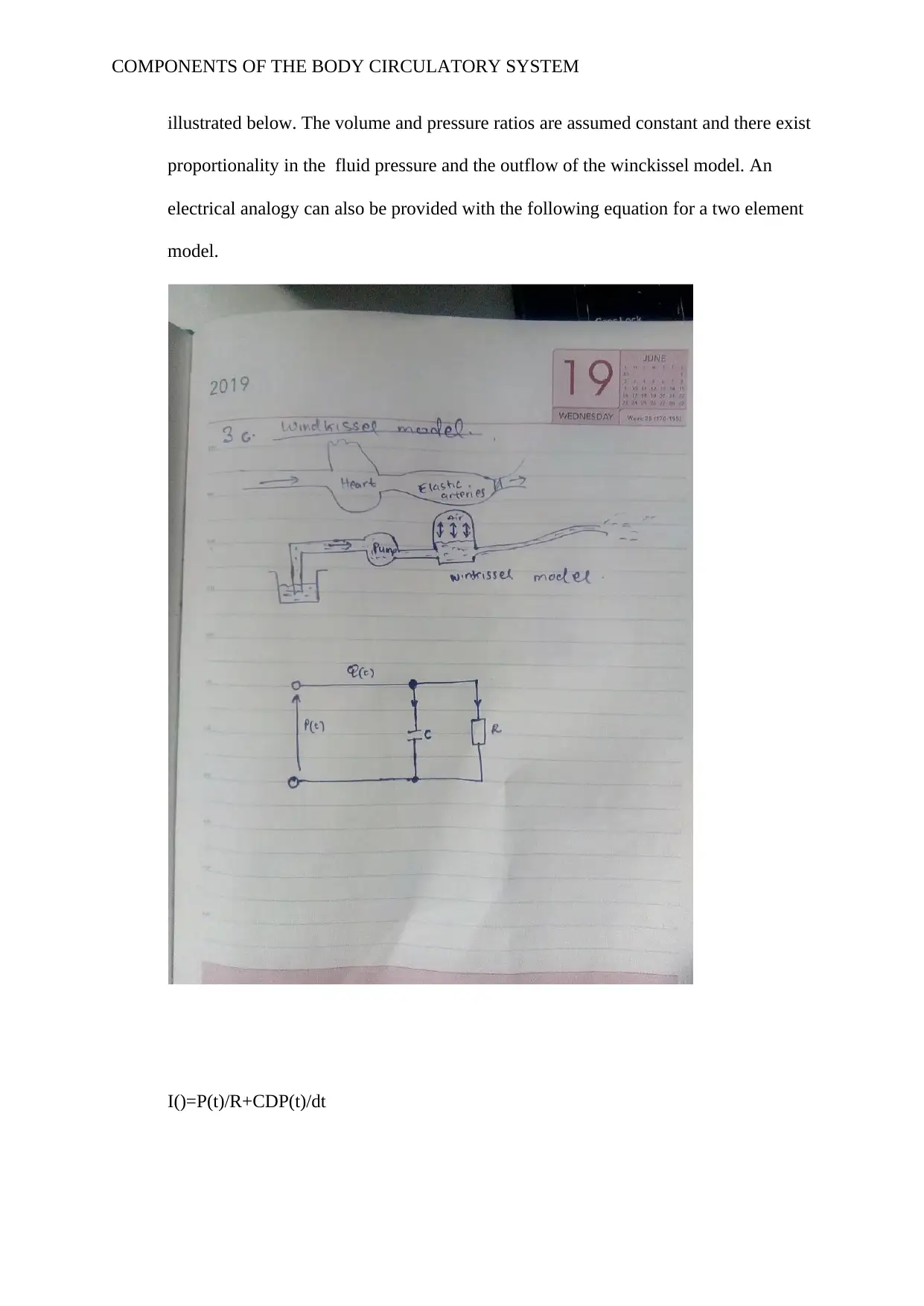
COMPONENTS OF THE BODY CIRCULATORY SYSTEM
illustrated below. The volume and pressure ratios are assumed constant and there exist
proportionality in the fluid pressure and the outflow of the winckissel model. An
electrical analogy can also be provided with the following equation for a two element
model.
I()=P(t)/R+CDP(t)/dt
illustrated below. The volume and pressure ratios are assumed constant and there exist
proportionality in the fluid pressure and the outflow of the winckissel model. An
electrical analogy can also be provided with the following equation for a two element
model.
I()=P(t)/R+CDP(t)/dt
Paraphrase This Document
Need a fresh take? Get an instant paraphrase of this document with our AI Paraphraser
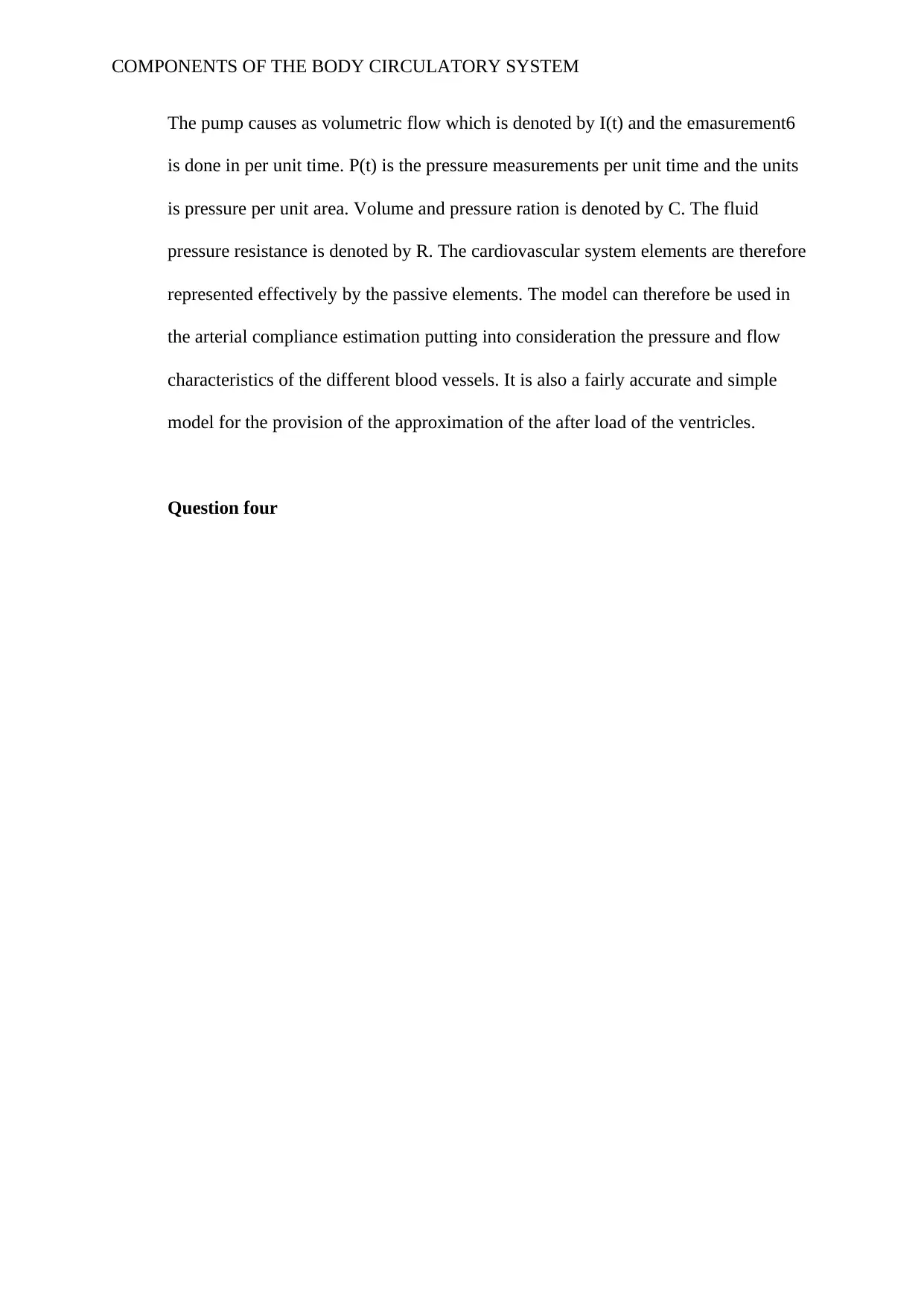
COMPONENTS OF THE BODY CIRCULATORY SYSTEM
The pump causes as volumetric flow which is denoted by I(t) and the emasurement6
is done in per unit time. P(t) is the pressure measurements per unit time and the units
is pressure per unit area. Volume and pressure ration is denoted by C. The fluid
pressure resistance is denoted by R. The cardiovascular system elements are therefore
represented effectively by the passive elements. The model can therefore be used in
the arterial compliance estimation putting into consideration the pressure and flow
characteristics of the different blood vessels. It is also a fairly accurate and simple
model for the provision of the approximation of the after load of the ventricles.
Question four
The pump causes as volumetric flow which is denoted by I(t) and the emasurement6
is done in per unit time. P(t) is the pressure measurements per unit time and the units
is pressure per unit area. Volume and pressure ration is denoted by C. The fluid
pressure resistance is denoted by R. The cardiovascular system elements are therefore
represented effectively by the passive elements. The model can therefore be used in
the arterial compliance estimation putting into consideration the pressure and flow
characteristics of the different blood vessels. It is also a fairly accurate and simple
model for the provision of the approximation of the after load of the ventricles.
Question four
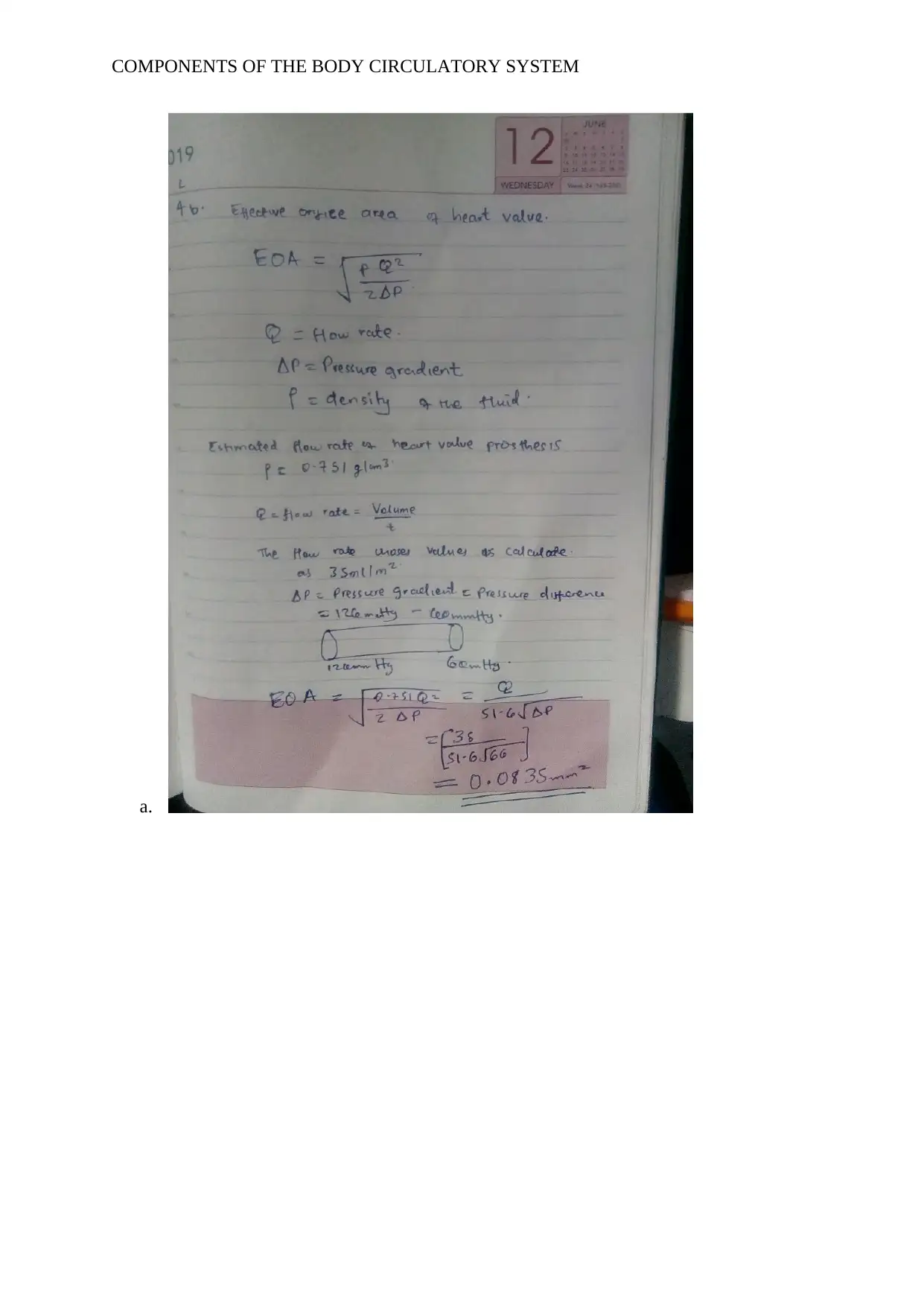
COMPONENTS OF THE BODY CIRCULATORY SYSTEM
a.
a.
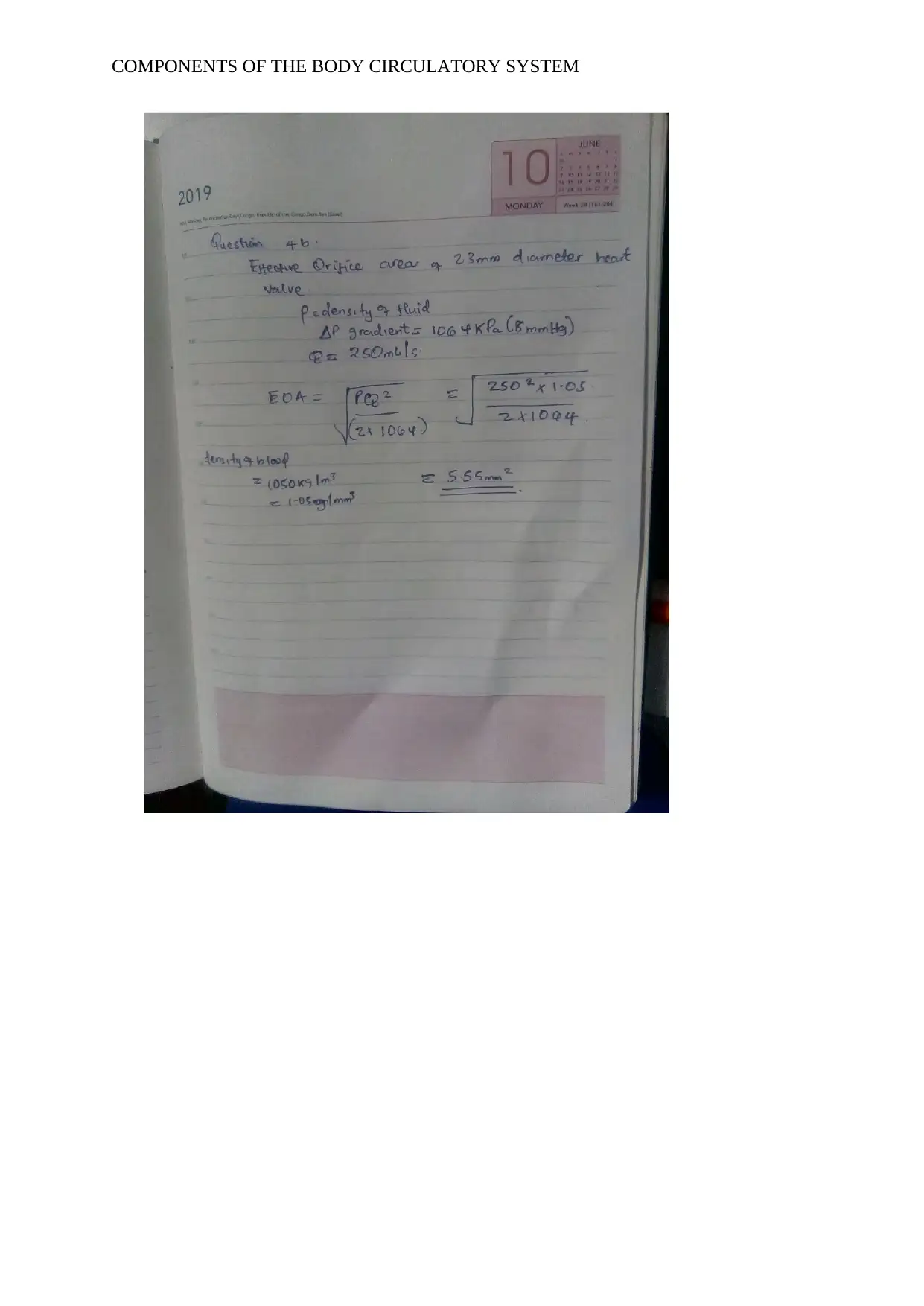
COMPONENTS OF THE BODY CIRCULATORY SYSTEM
Secure Best Marks with AI Grader
Need help grading? Try our AI Grader for instant feedback on your assignments.
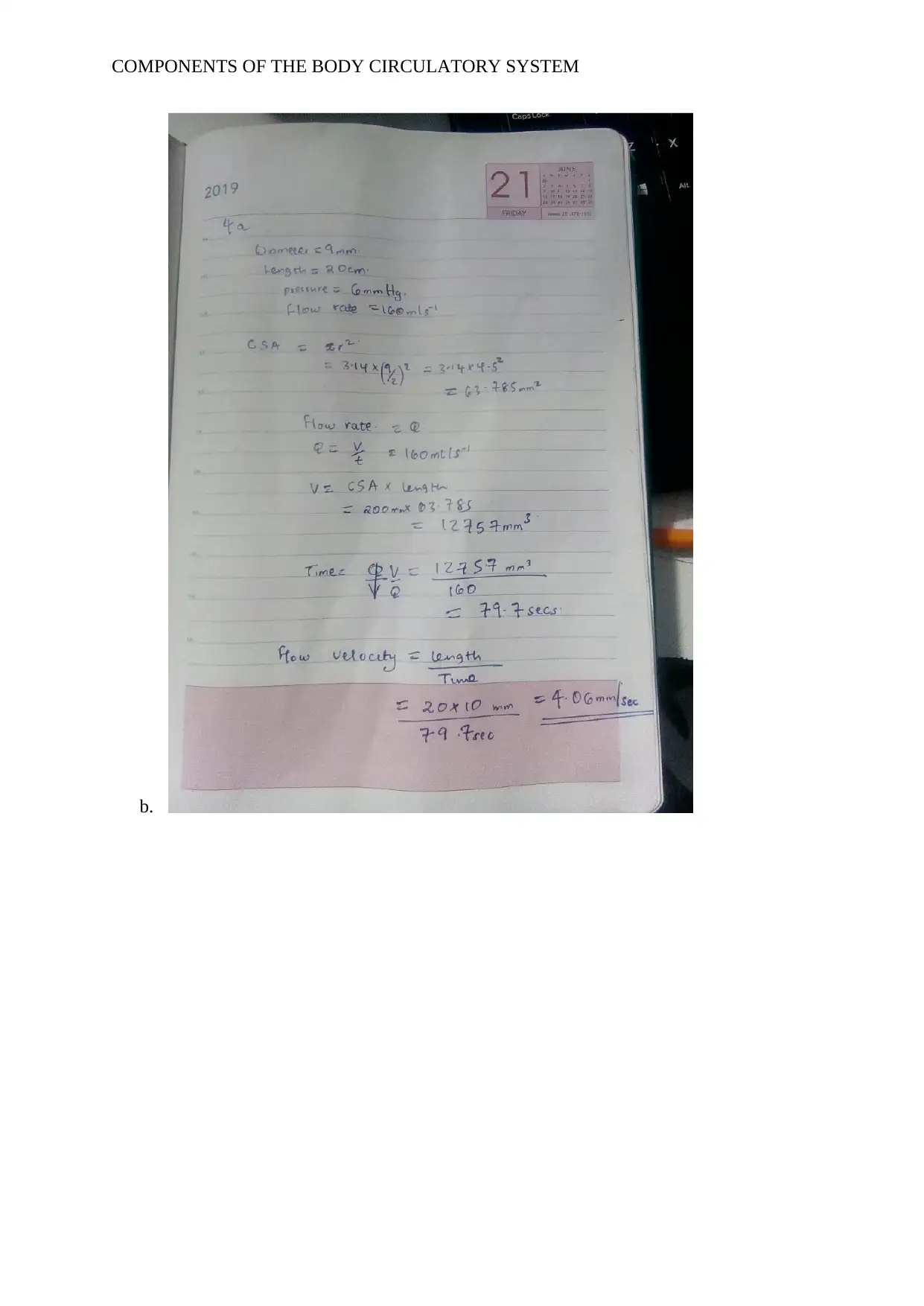
COMPONENTS OF THE BODY CIRCULATORY SYSTEM
b.
b.
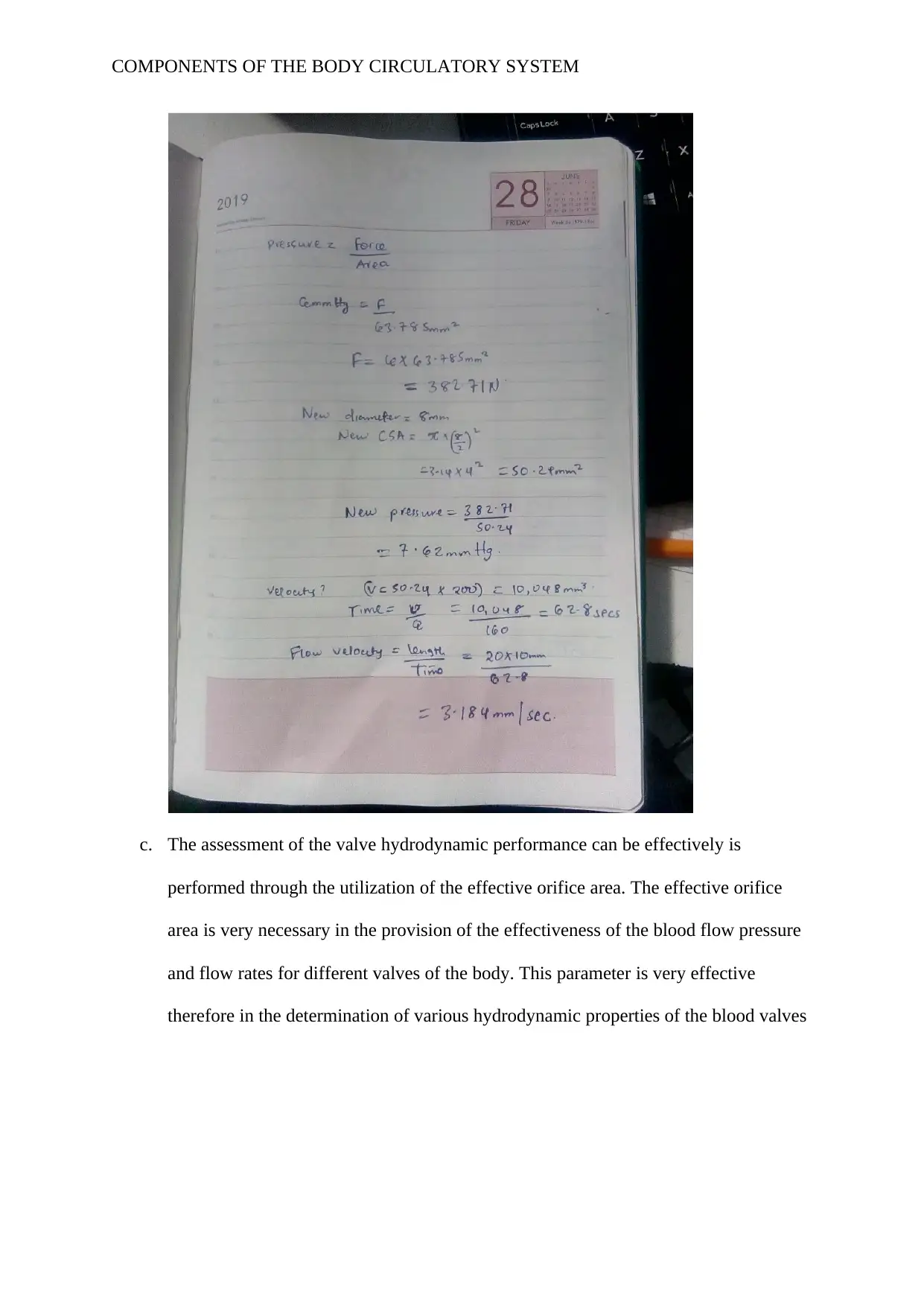
COMPONENTS OF THE BODY CIRCULATORY SYSTEM
c. The assessment of the valve hydrodynamic performance can be effectively is
performed through the utilization of the effective orifice area. The effective orifice
area is very necessary in the provision of the effectiveness of the blood flow pressure
and flow rates for different valves of the body. This parameter is very effective
therefore in the determination of various hydrodynamic properties of the blood valves
c. The assessment of the valve hydrodynamic performance can be effectively is
performed through the utilization of the effective orifice area. The effective orifice
area is very necessary in the provision of the effectiveness of the blood flow pressure
and flow rates for different valves of the body. This parameter is very effective
therefore in the determination of various hydrodynamic properties of the blood valves
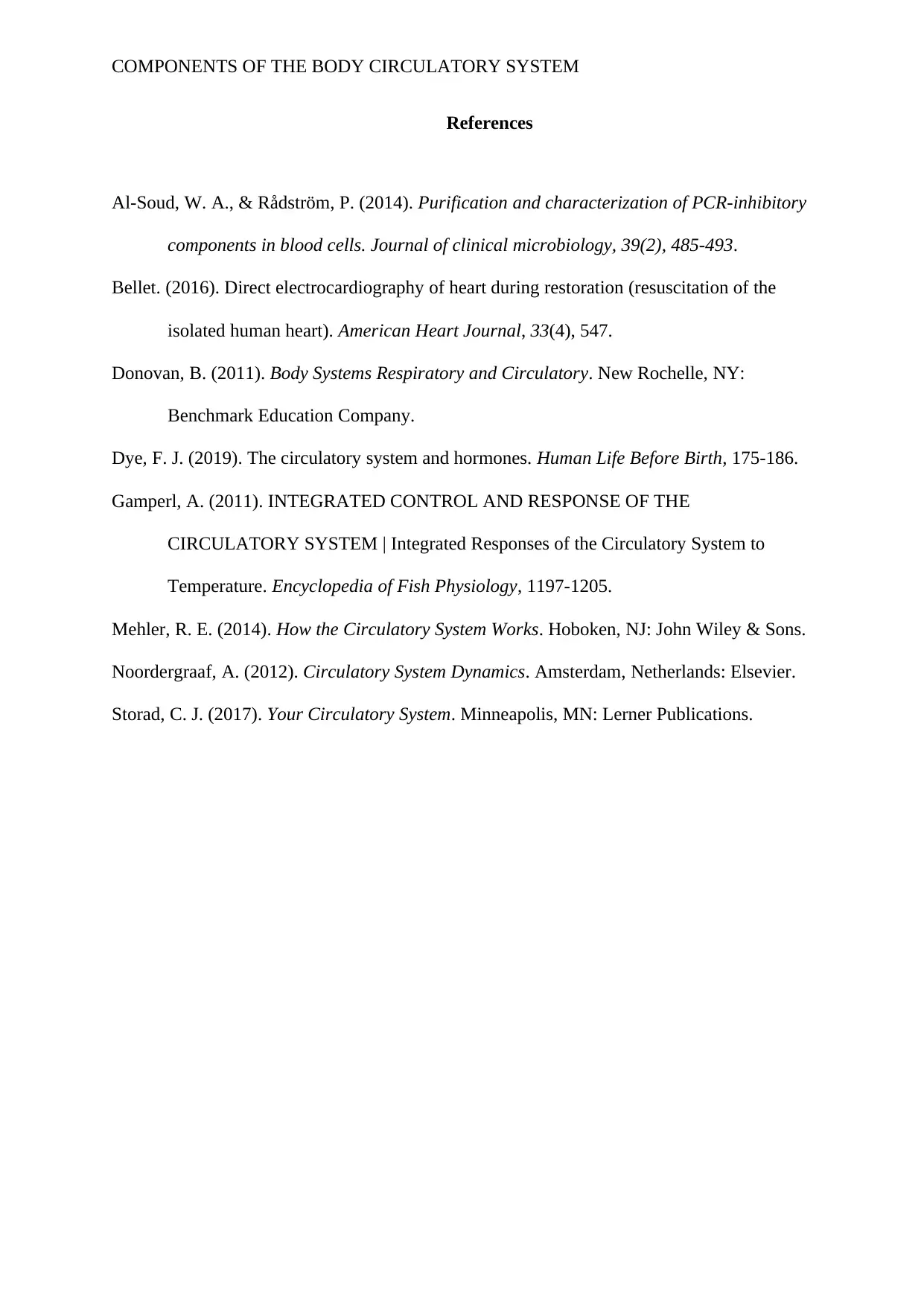
COMPONENTS OF THE BODY CIRCULATORY SYSTEM
References
Al-Soud, W. A., & Rådström, P. (2014). Purification and characterization of PCR-inhibitory
components in blood cells. Journal of clinical microbiology, 39(2), 485-493.
Bellet. (2016). Direct electrocardiography of heart during restoration (resuscitation of the
isolated human heart). American Heart Journal, 33(4), 547.
Donovan, B. (2011). Body Systems Respiratory and Circulatory. New Rochelle, NY:
Benchmark Education Company.
Dye, F. J. (2019). The circulatory system and hormones. Human Life Before Birth, 175-186.
Gamperl, A. (2011). INTEGRATED CONTROL AND RESPONSE OF THE
CIRCULATORY SYSTEM | Integrated Responses of the Circulatory System to
Temperature. Encyclopedia of Fish Physiology, 1197-1205.
Mehler, R. E. (2014). How the Circulatory System Works. Hoboken, NJ: John Wiley & Sons.
Noordergraaf, A. (2012). Circulatory System Dynamics. Amsterdam, Netherlands: Elsevier.
Storad, C. J. (2017). Your Circulatory System. Minneapolis, MN: Lerner Publications.
References
Al-Soud, W. A., & Rådström, P. (2014). Purification and characterization of PCR-inhibitory
components in blood cells. Journal of clinical microbiology, 39(2), 485-493.
Bellet. (2016). Direct electrocardiography of heart during restoration (resuscitation of the
isolated human heart). American Heart Journal, 33(4), 547.
Donovan, B. (2011). Body Systems Respiratory and Circulatory. New Rochelle, NY:
Benchmark Education Company.
Dye, F. J. (2019). The circulatory system and hormones. Human Life Before Birth, 175-186.
Gamperl, A. (2011). INTEGRATED CONTROL AND RESPONSE OF THE
CIRCULATORY SYSTEM | Integrated Responses of the Circulatory System to
Temperature. Encyclopedia of Fish Physiology, 1197-1205.
Mehler, R. E. (2014). How the Circulatory System Works. Hoboken, NJ: John Wiley & Sons.
Noordergraaf, A. (2012). Circulatory System Dynamics. Amsterdam, Netherlands: Elsevier.
Storad, C. J. (2017). Your Circulatory System. Minneapolis, MN: Lerner Publications.
1 out of 25
Related Documents
Your All-in-One AI-Powered Toolkit for Academic Success.
+13062052269
info@desklib.com
Available 24*7 on WhatsApp / Email
![[object Object]](/_next/static/media/star-bottom.7253800d.svg)
Unlock your academic potential
© 2024 | Zucol Services PVT LTD | All rights reserved.




